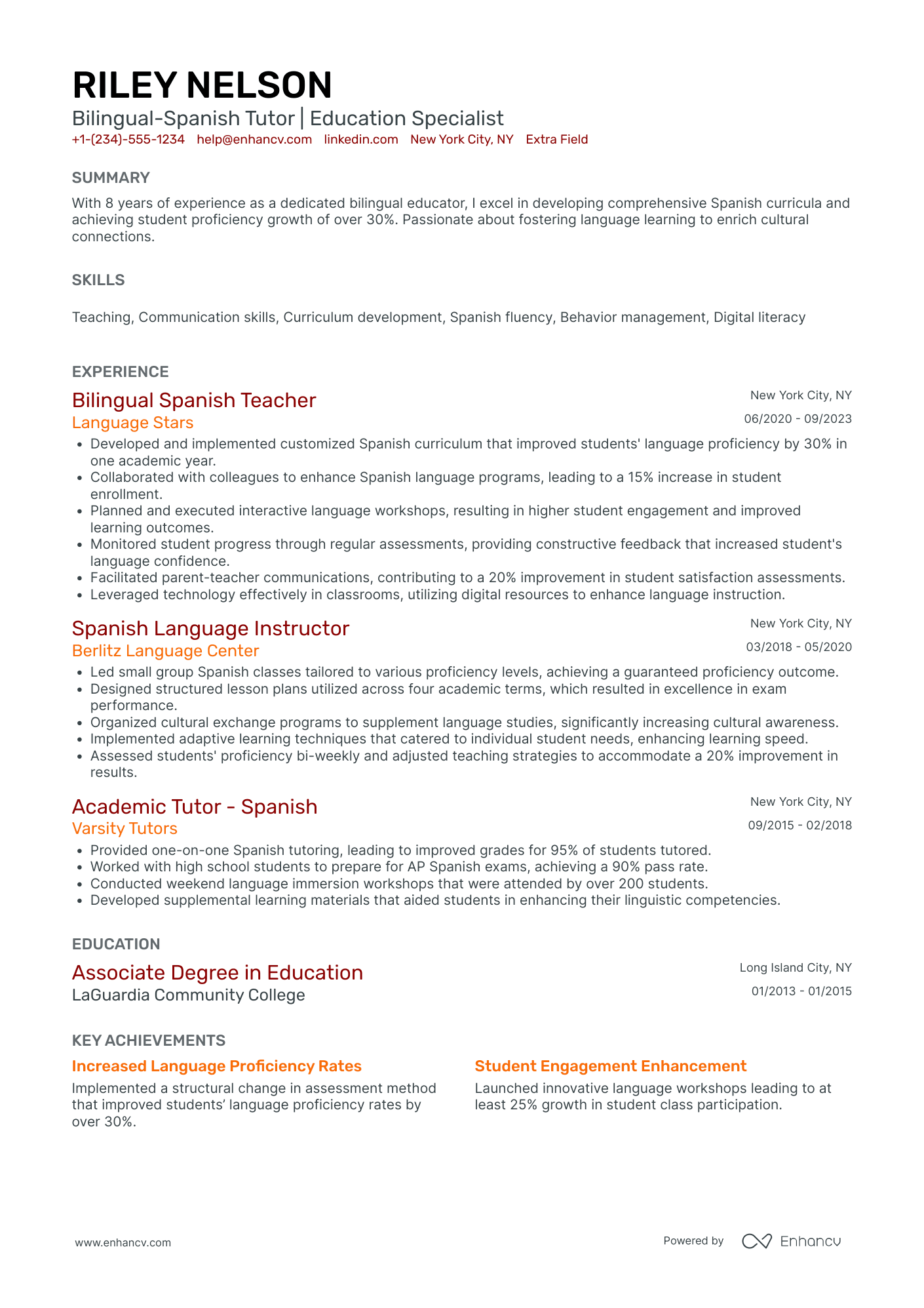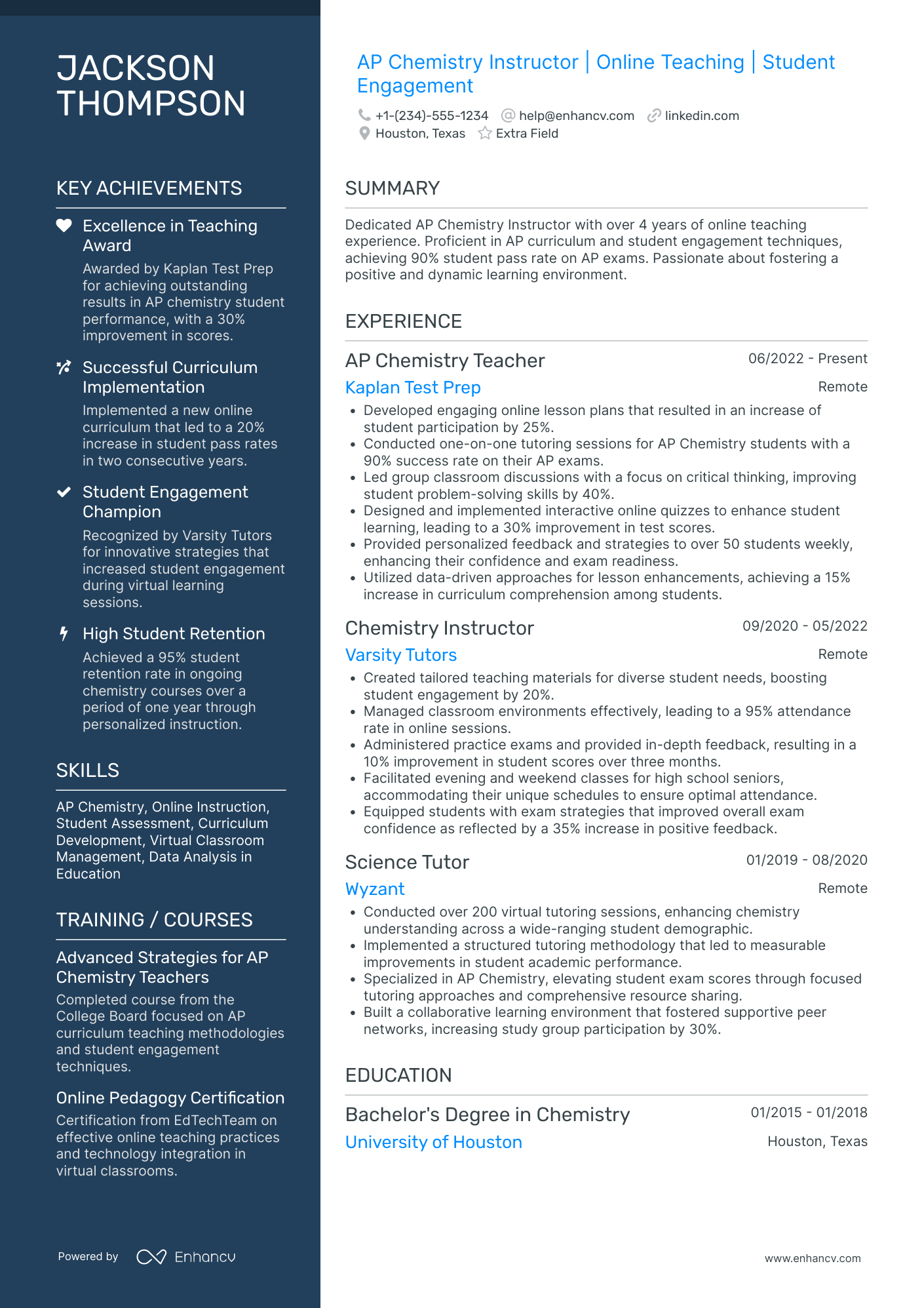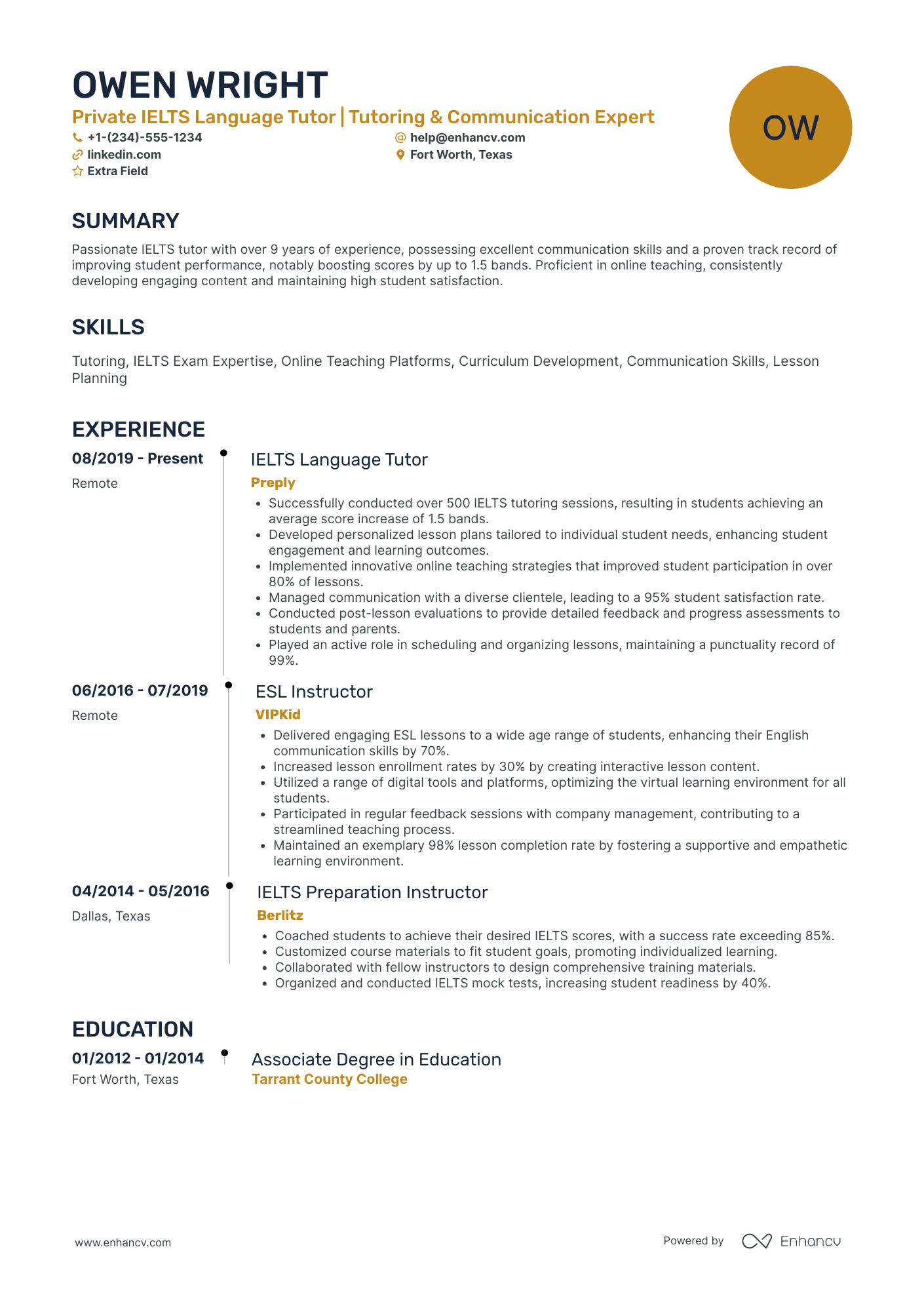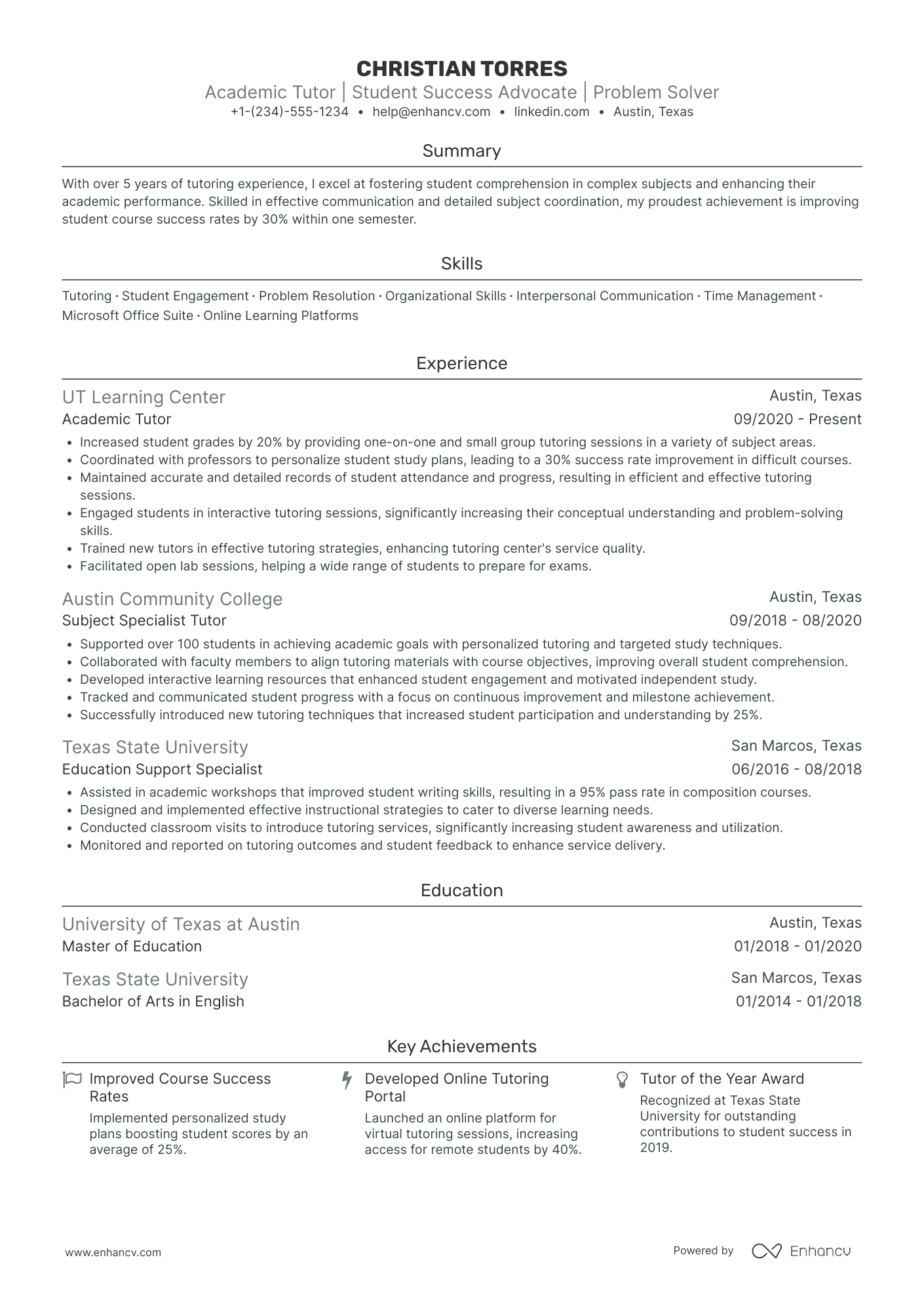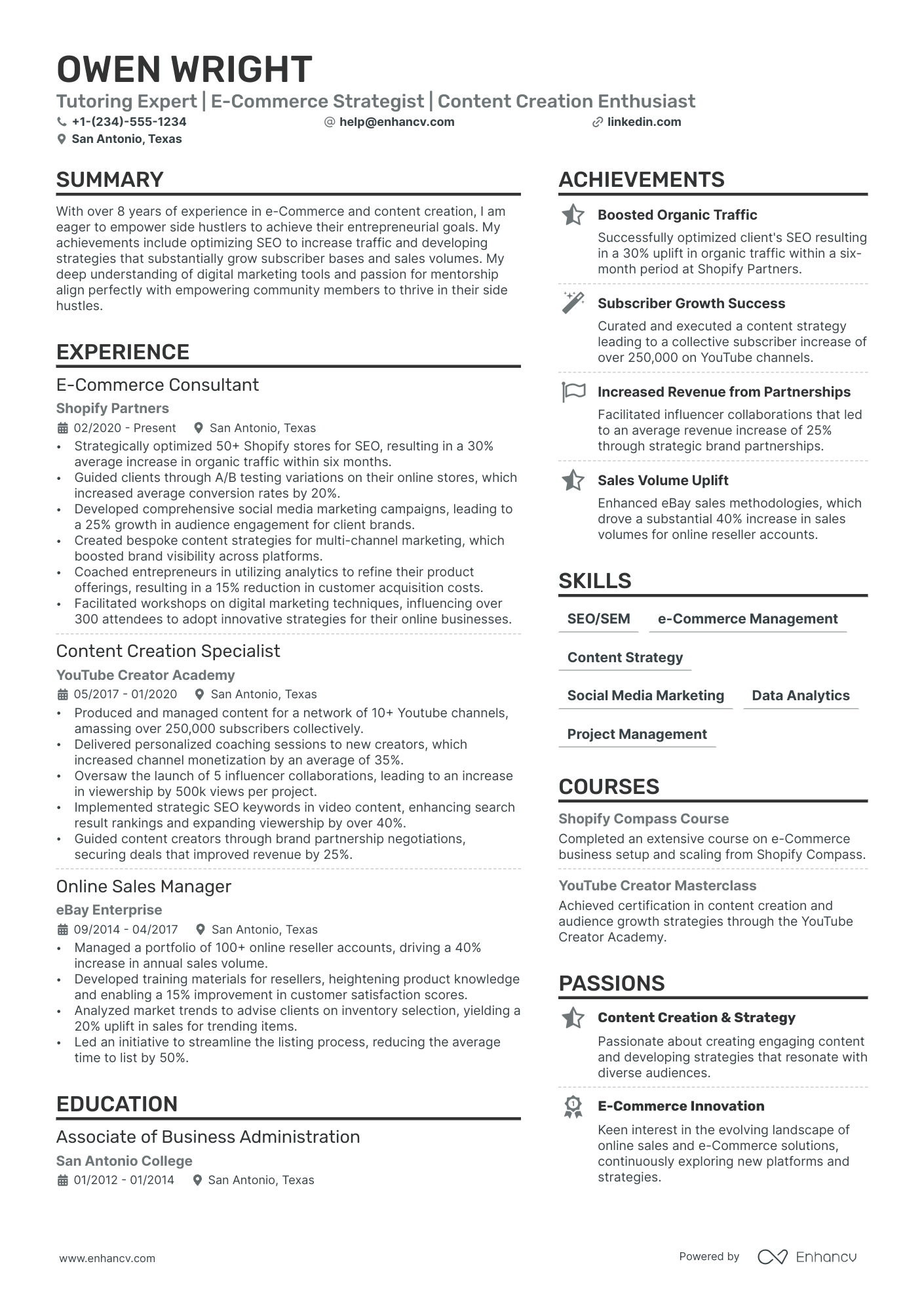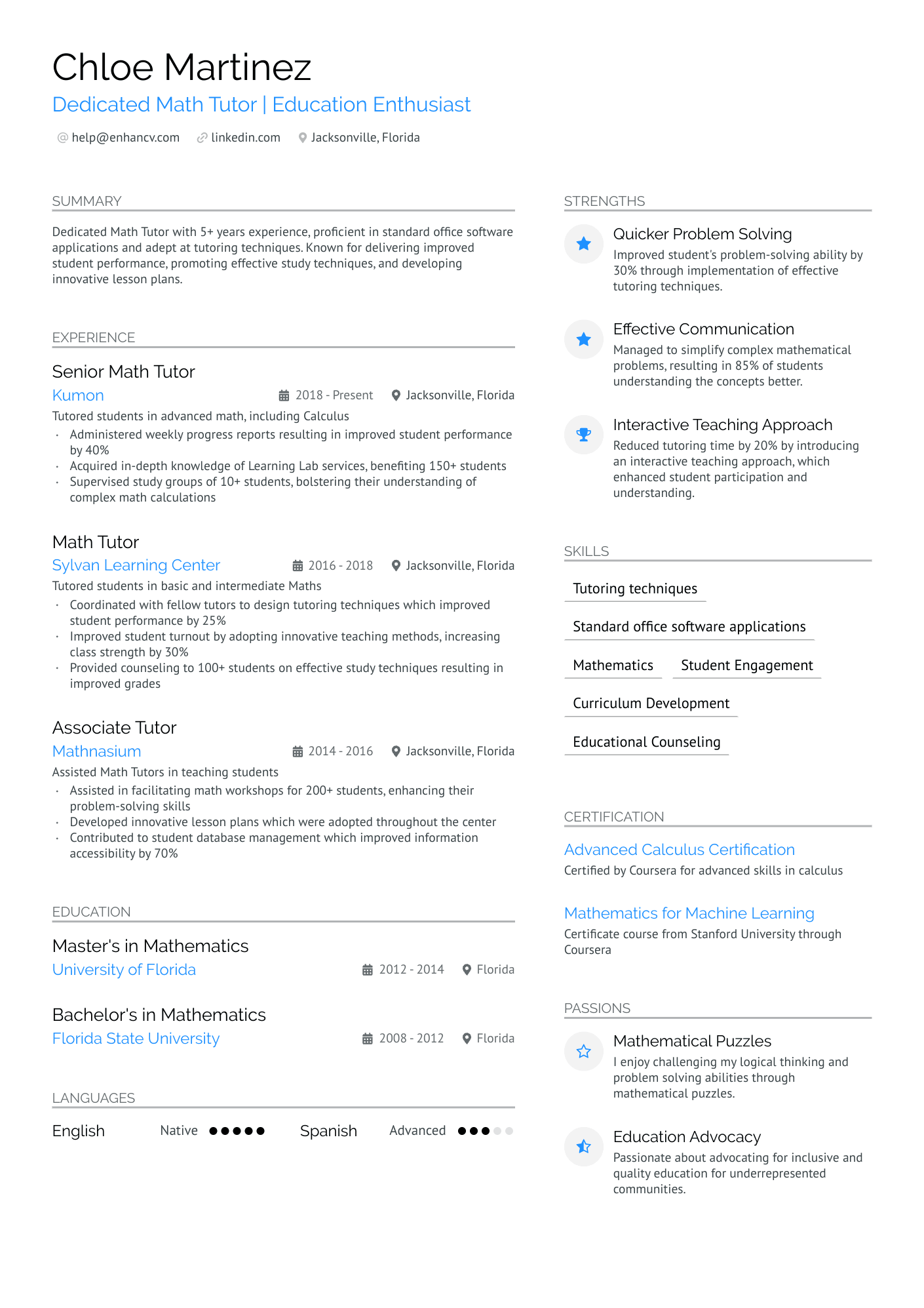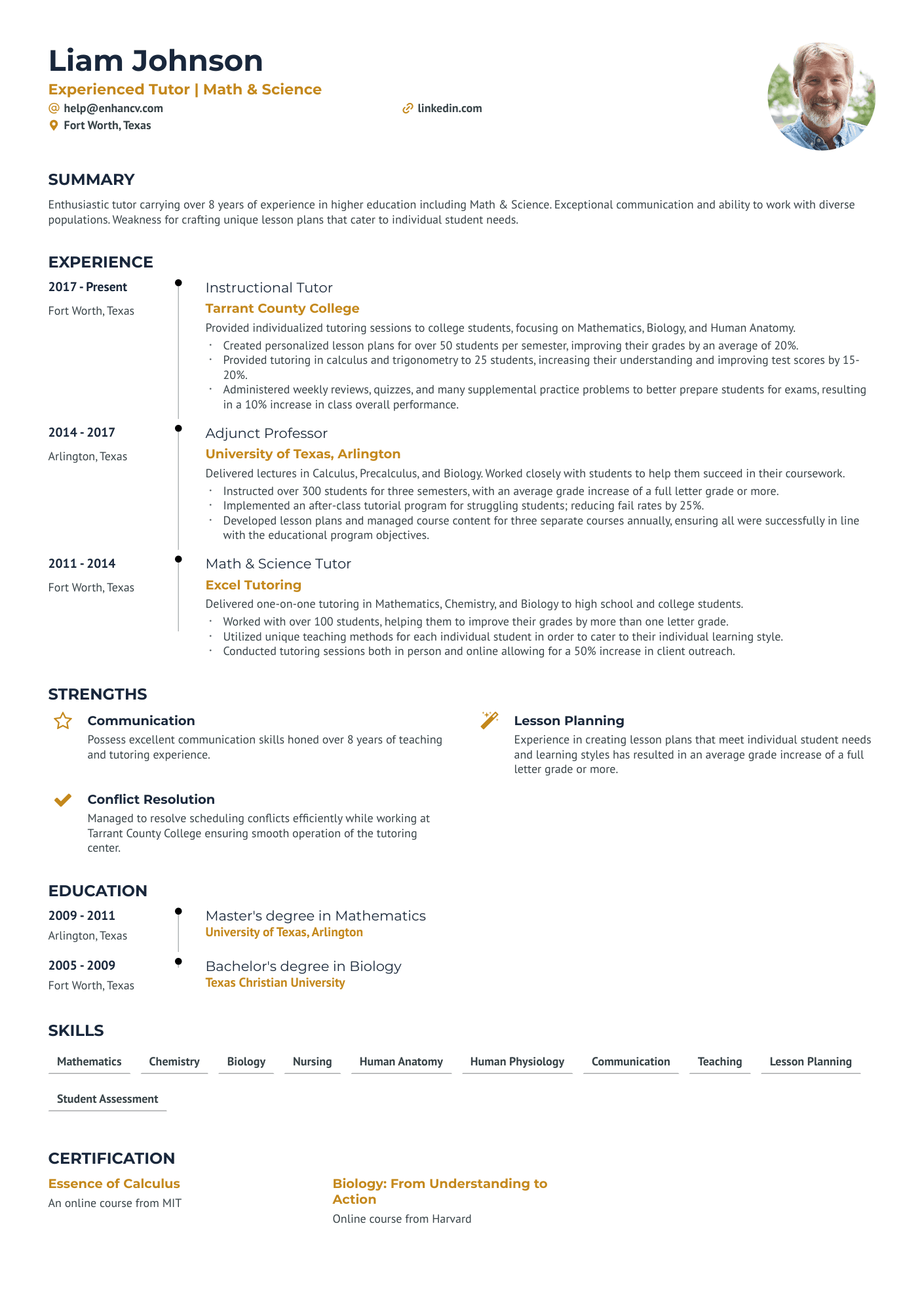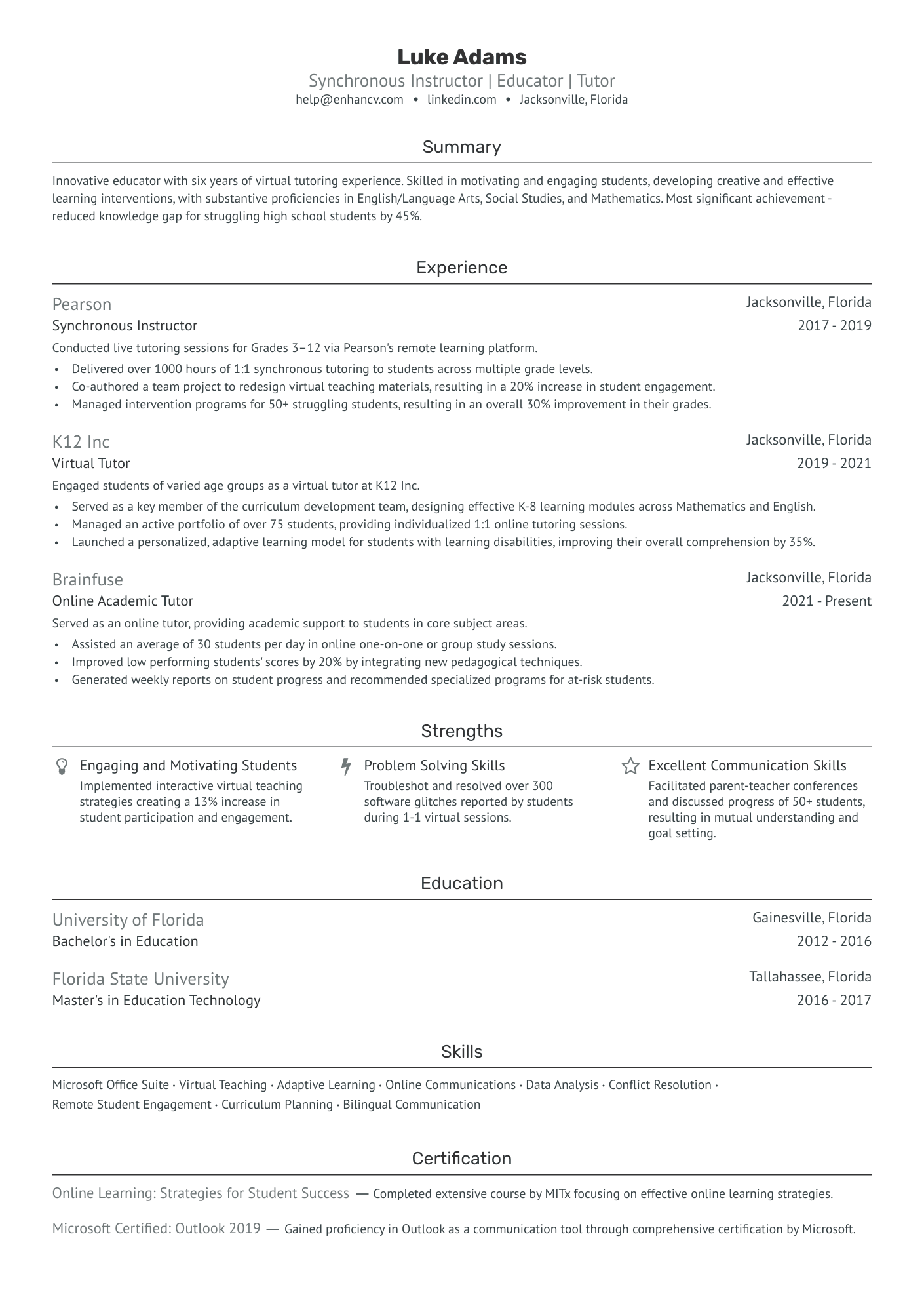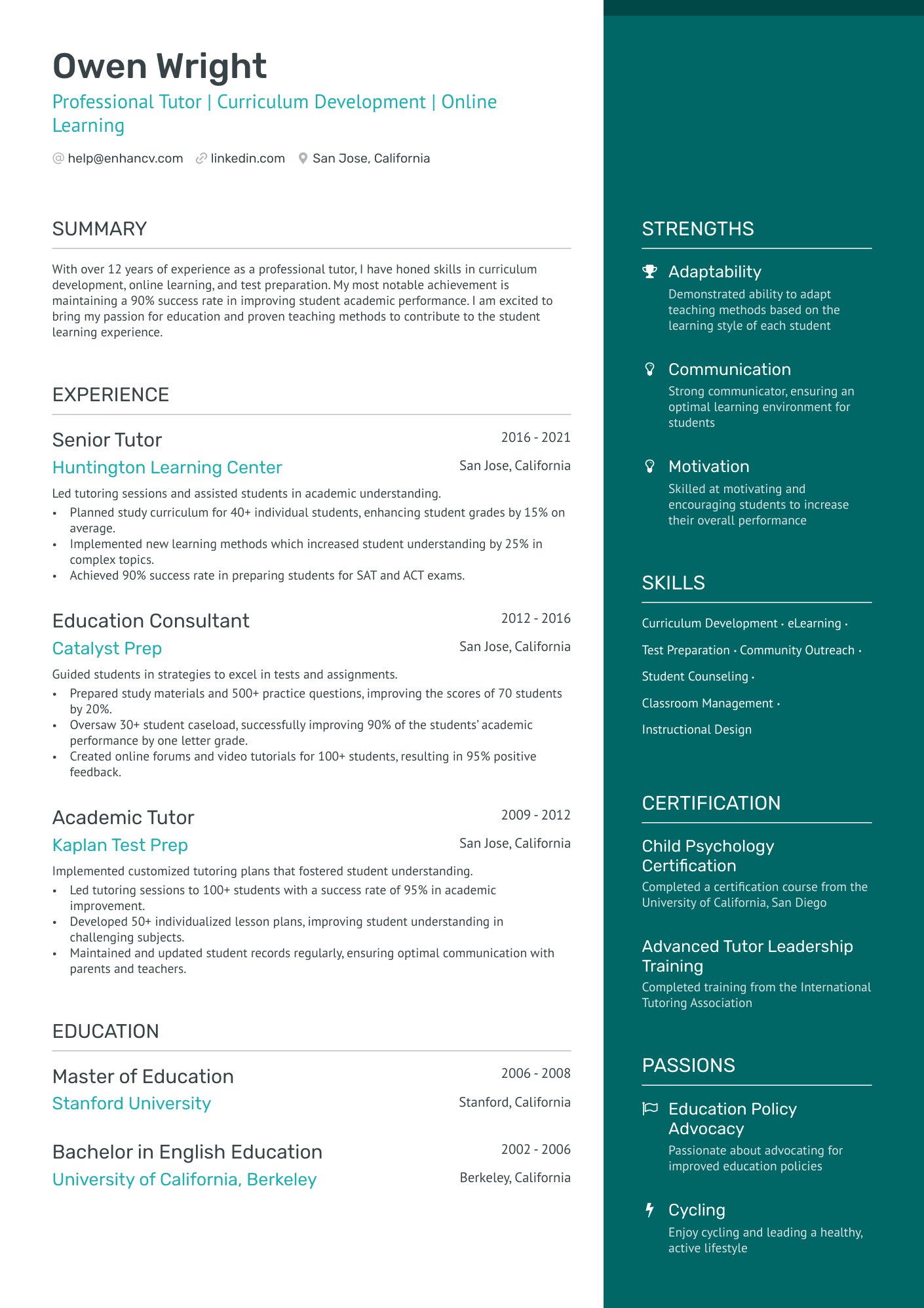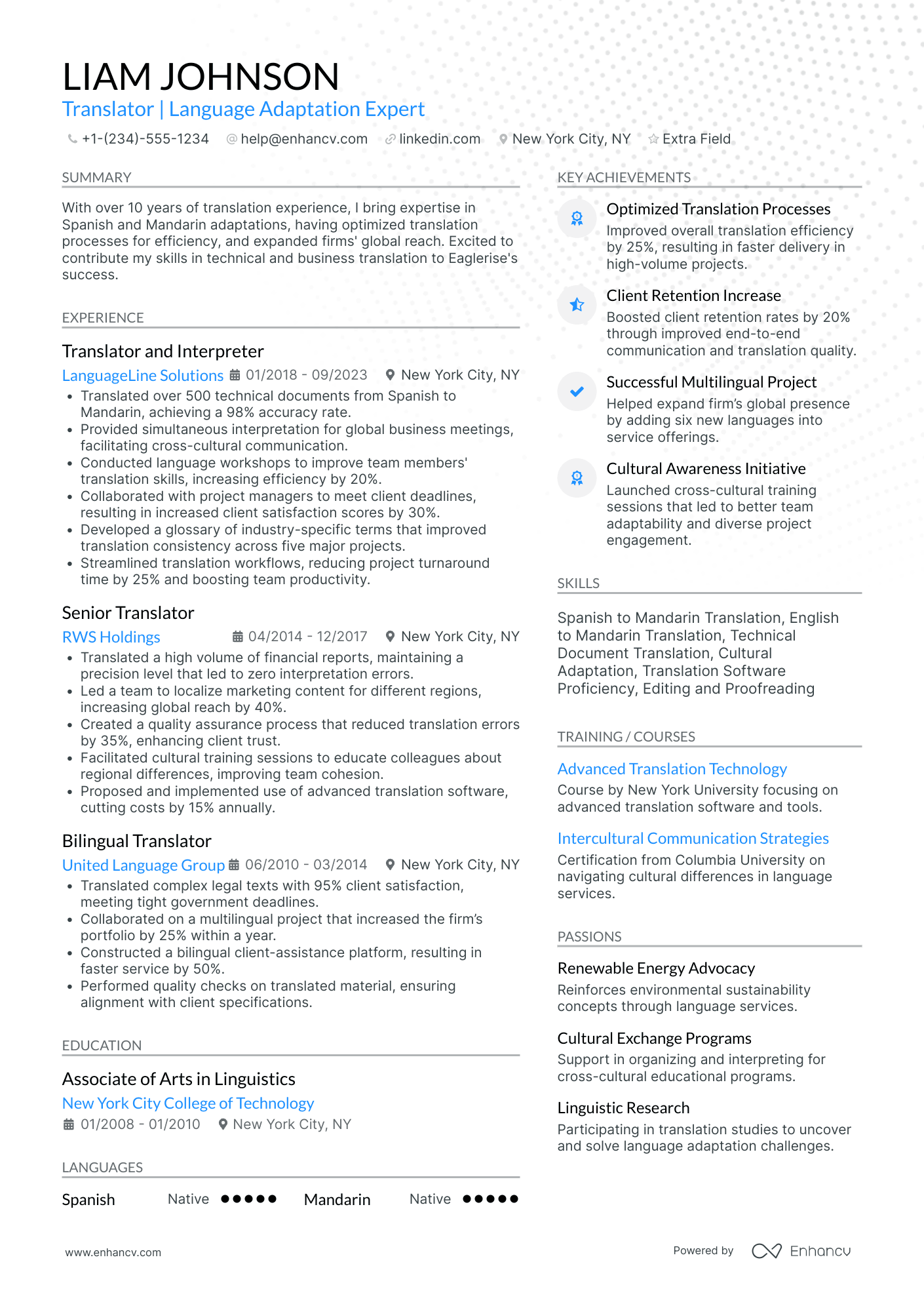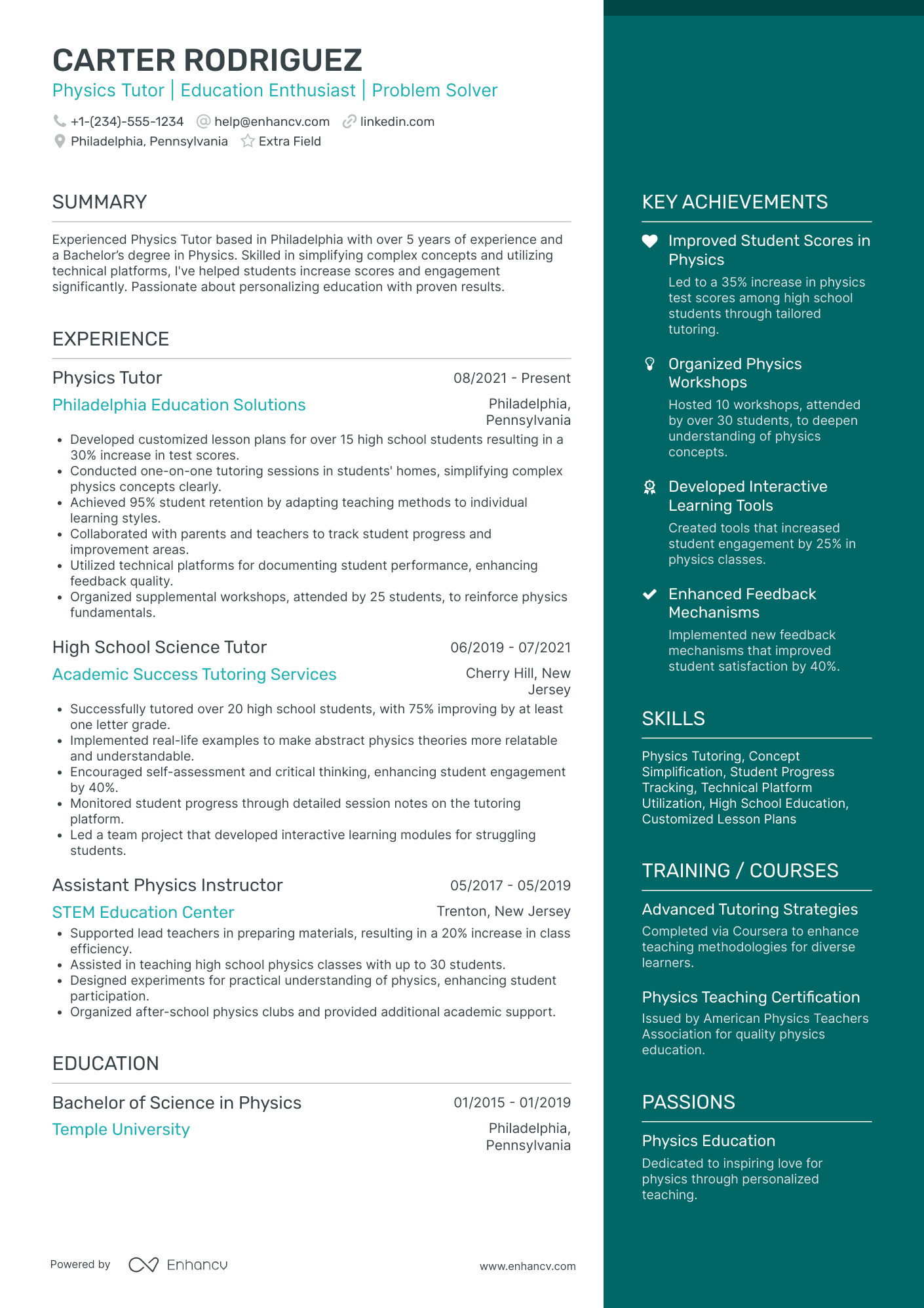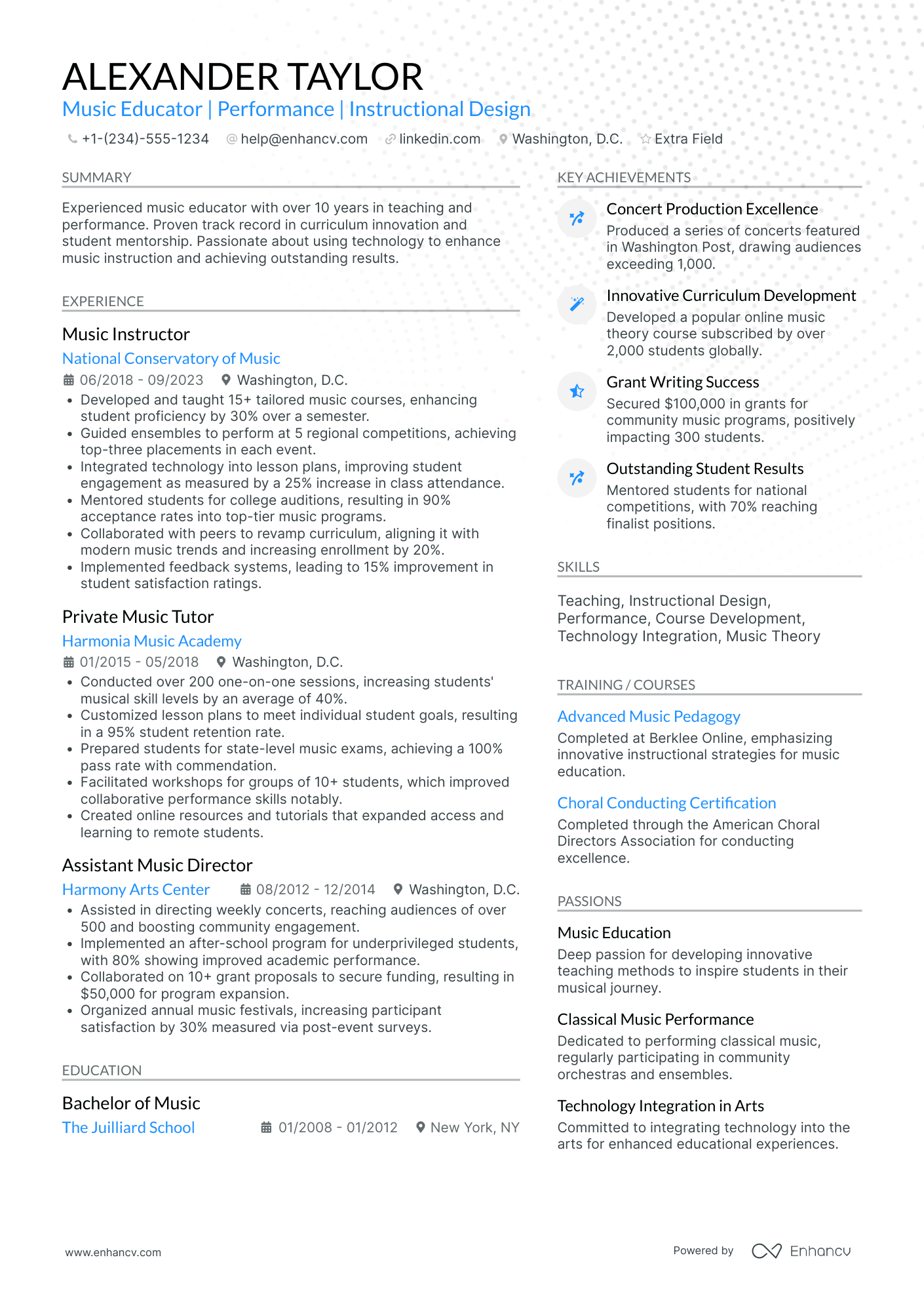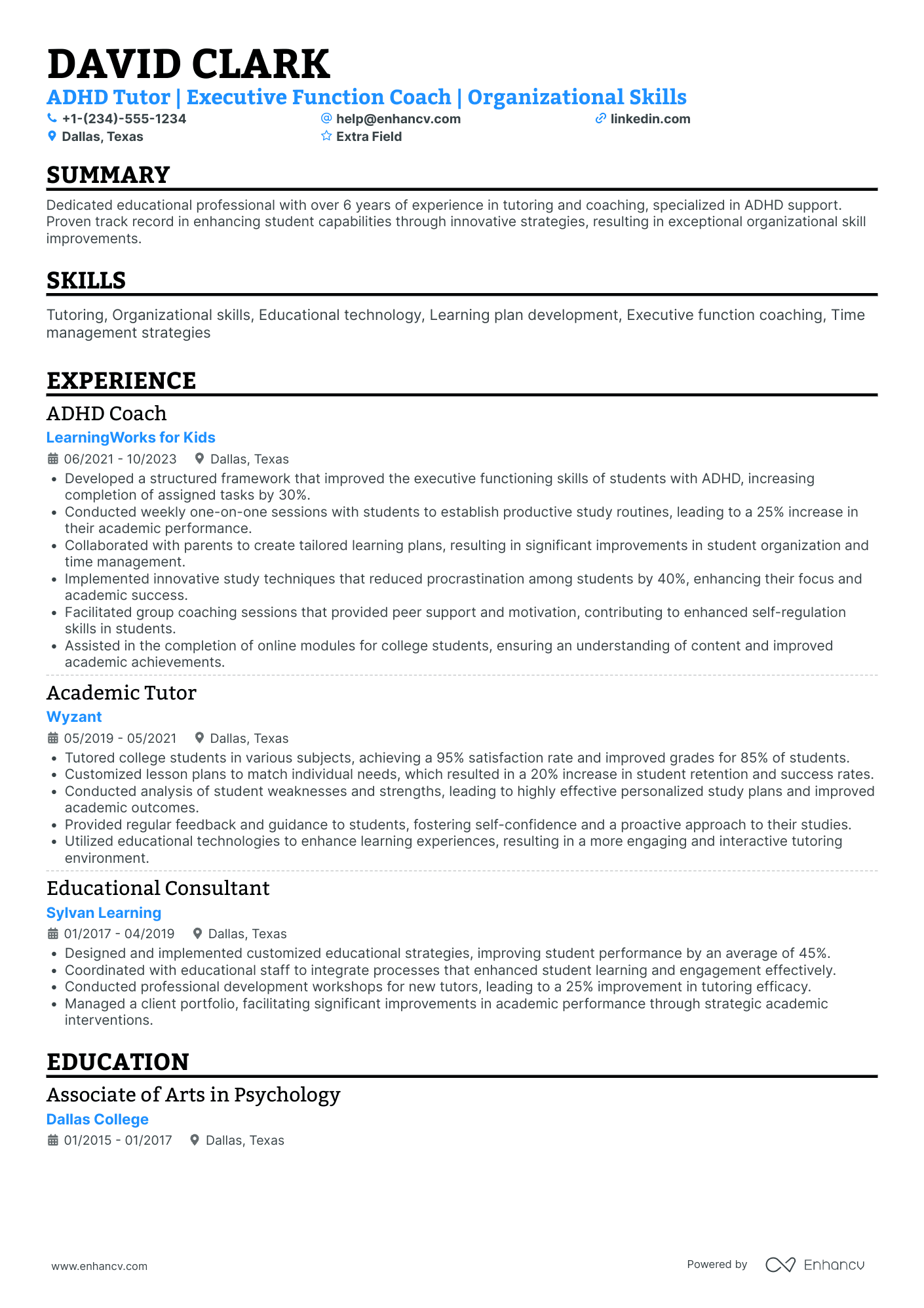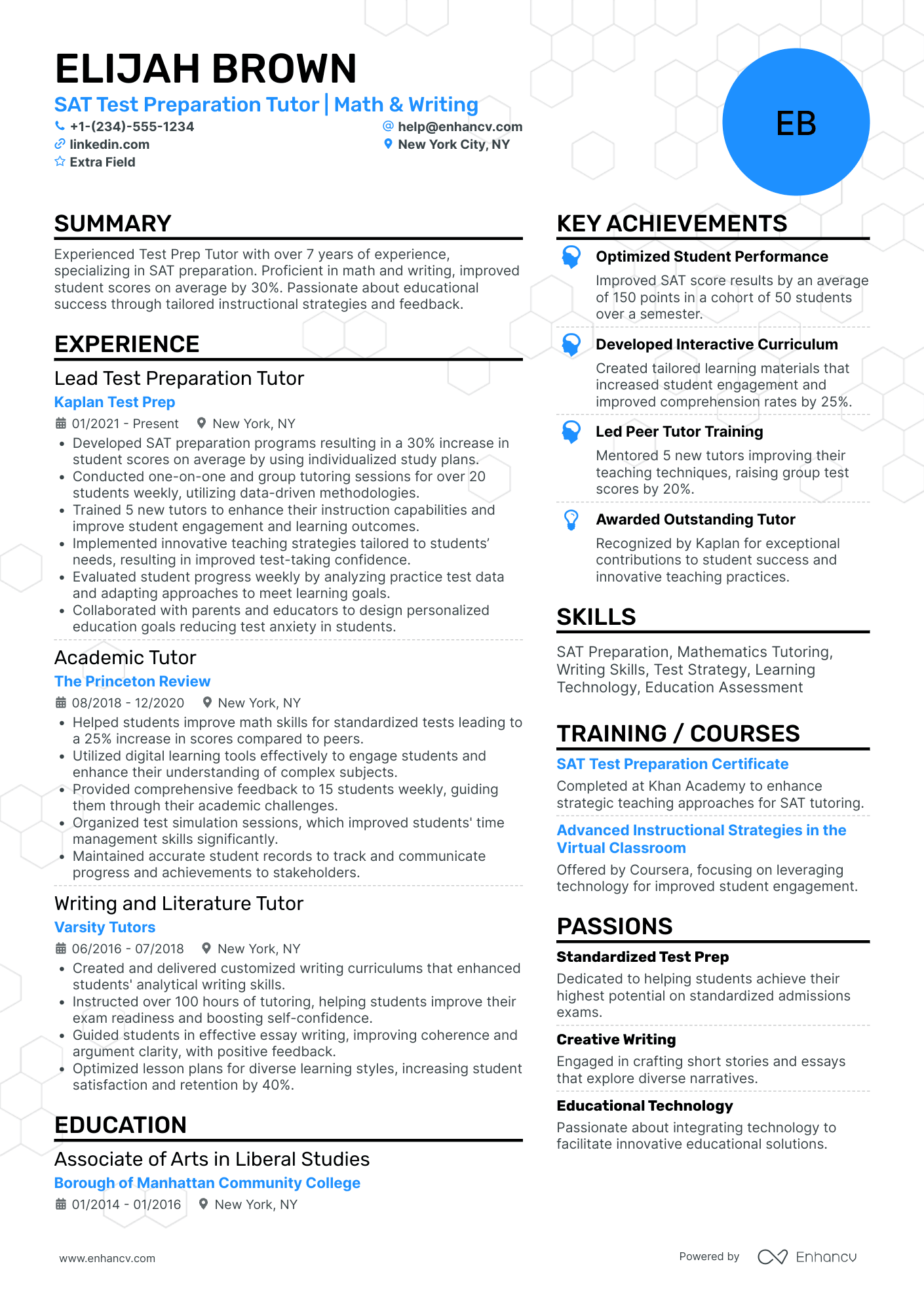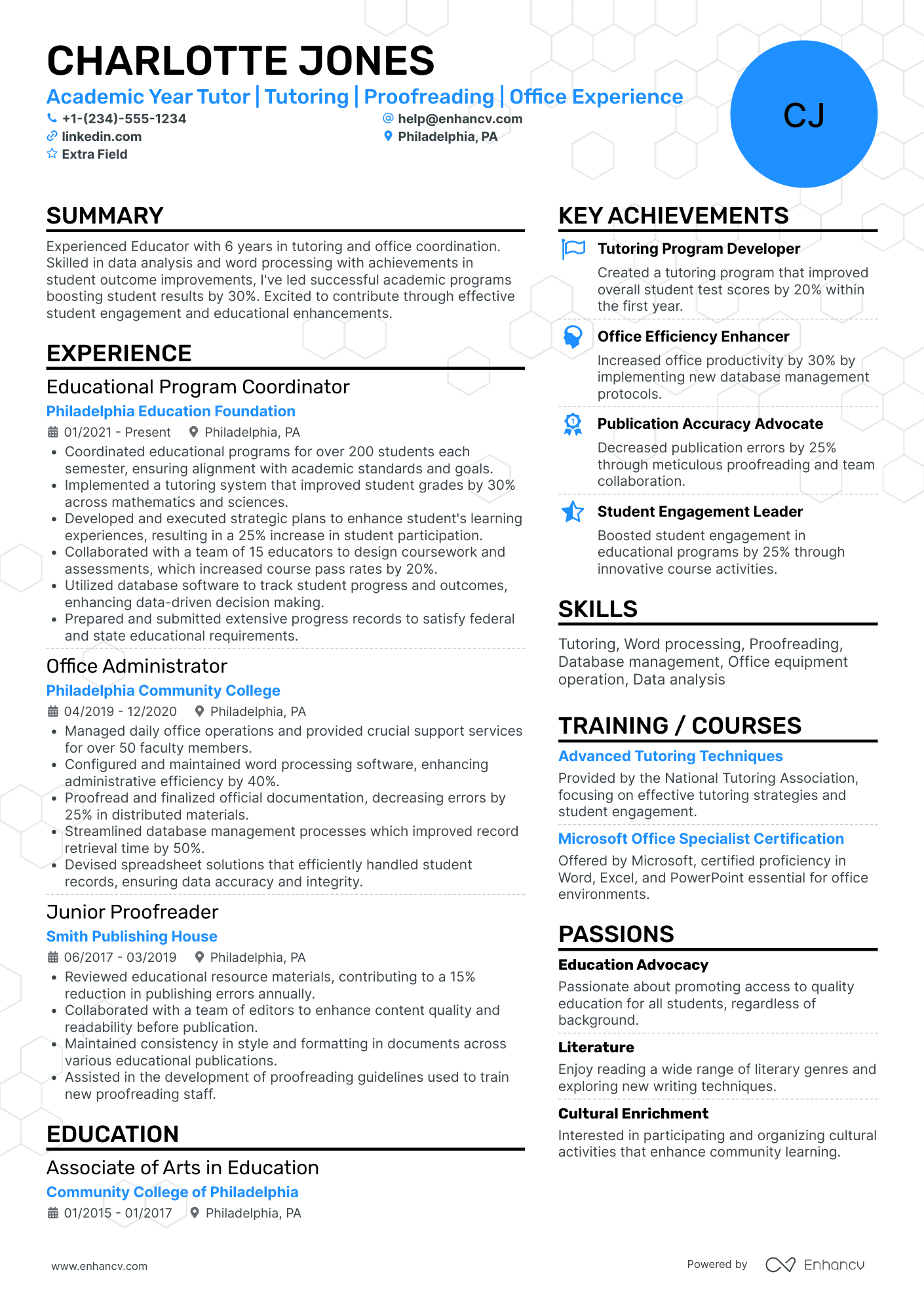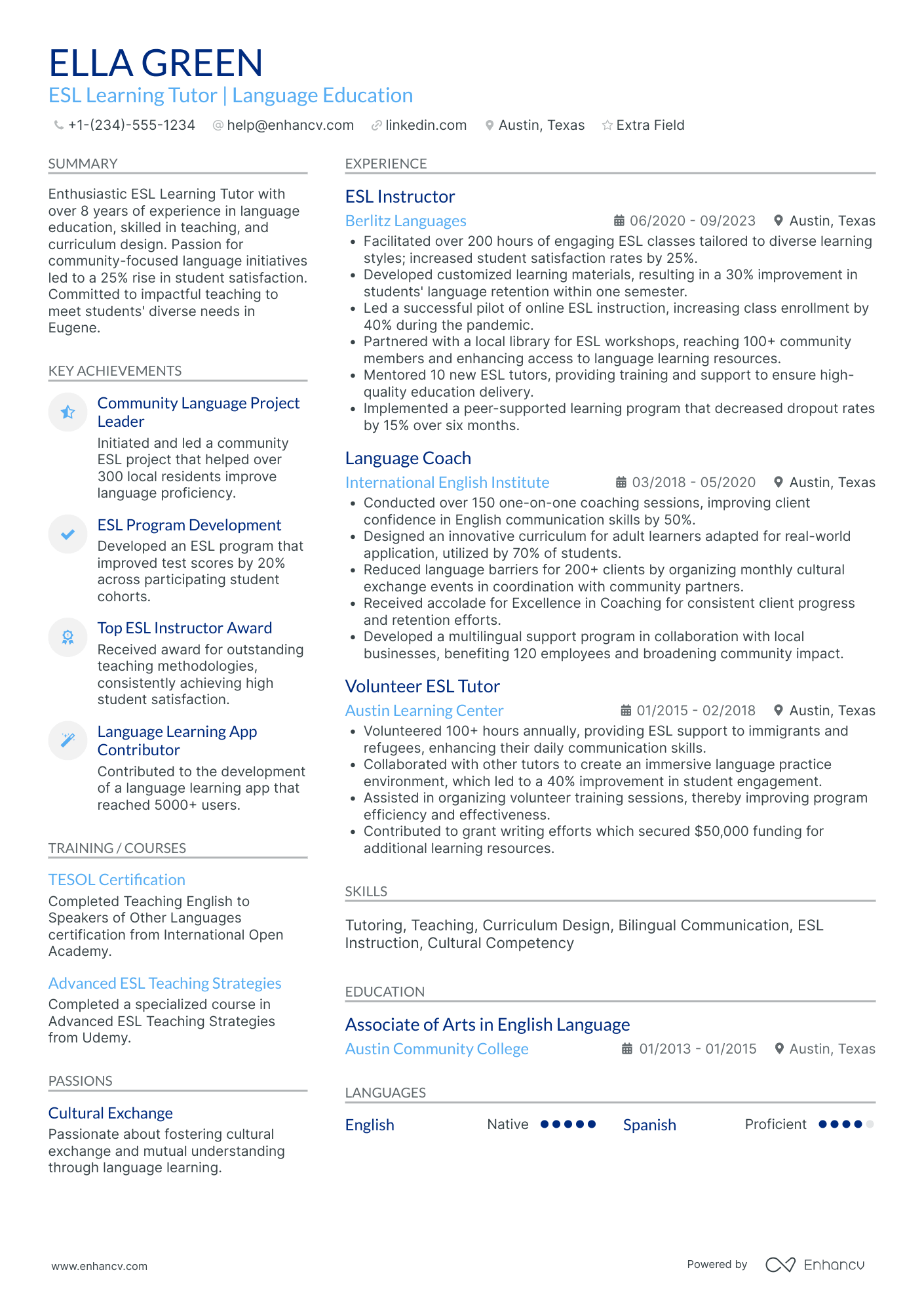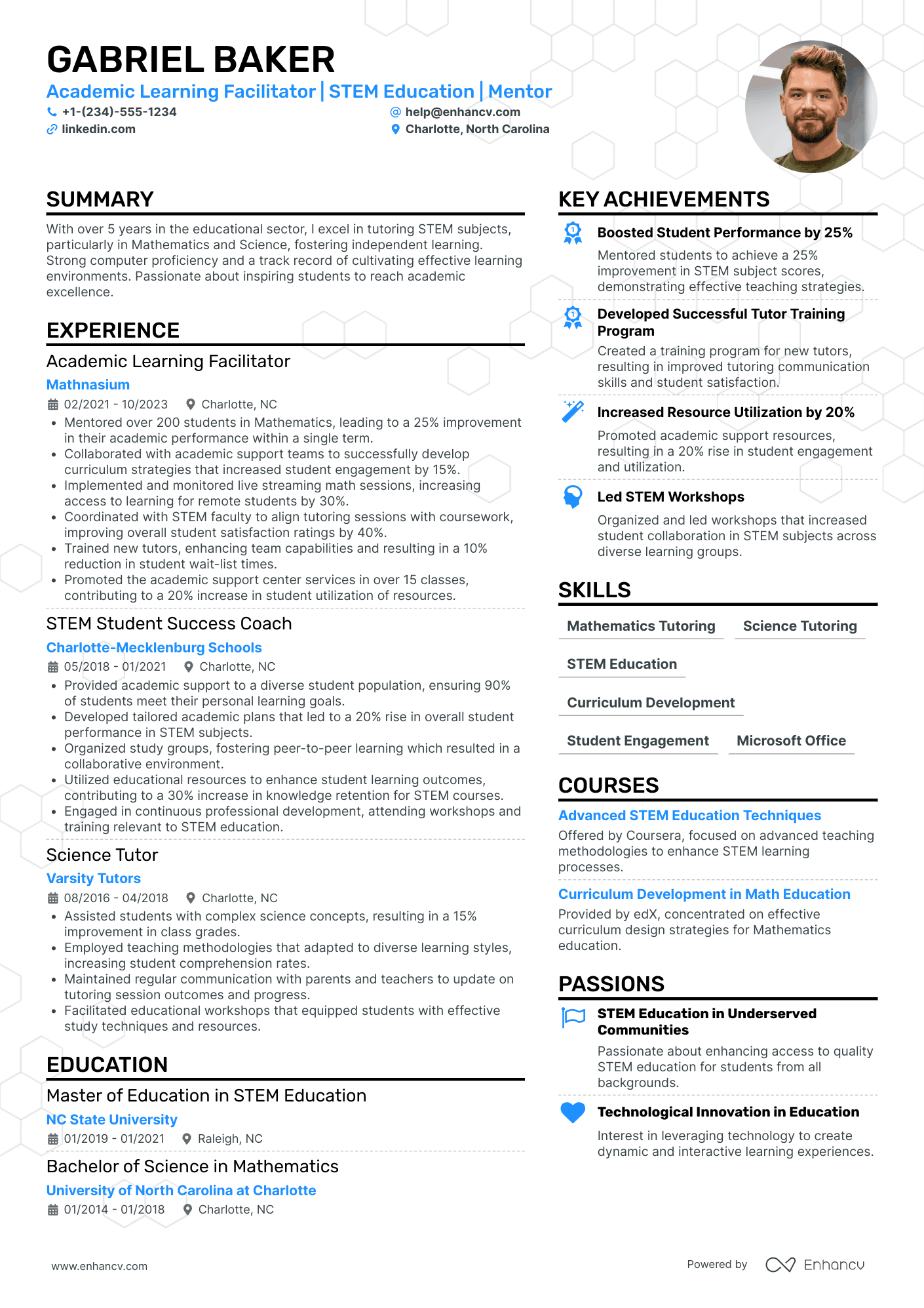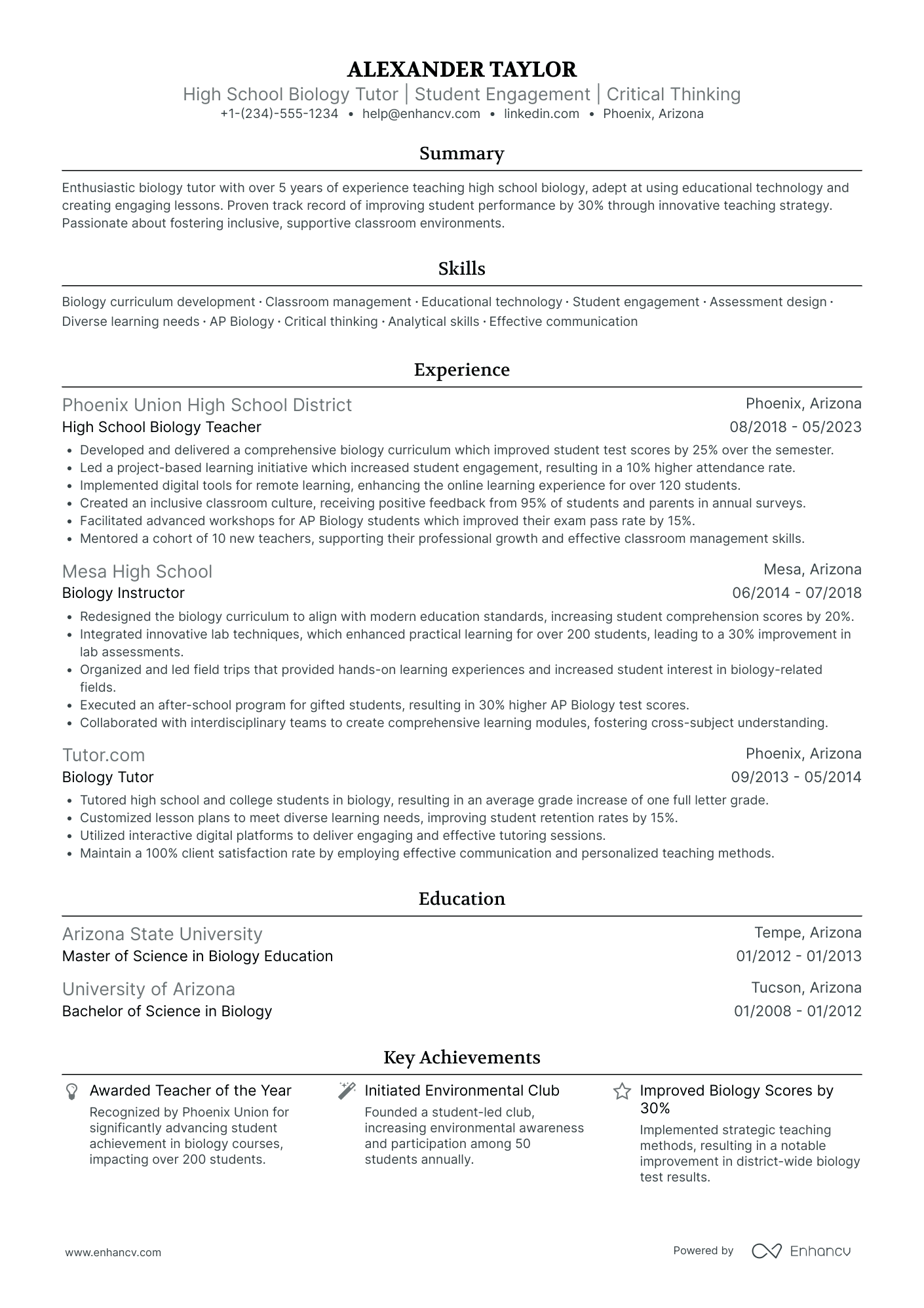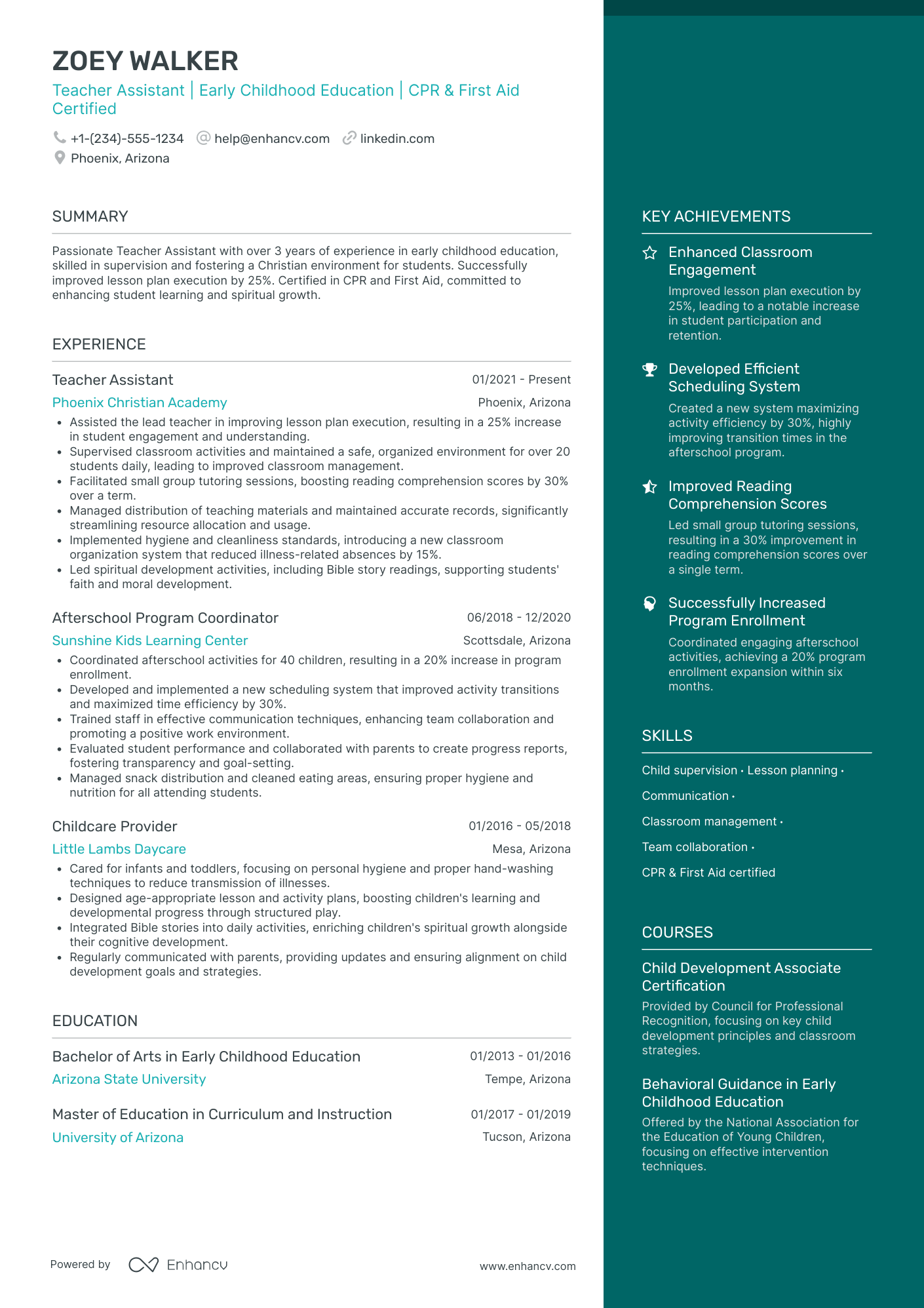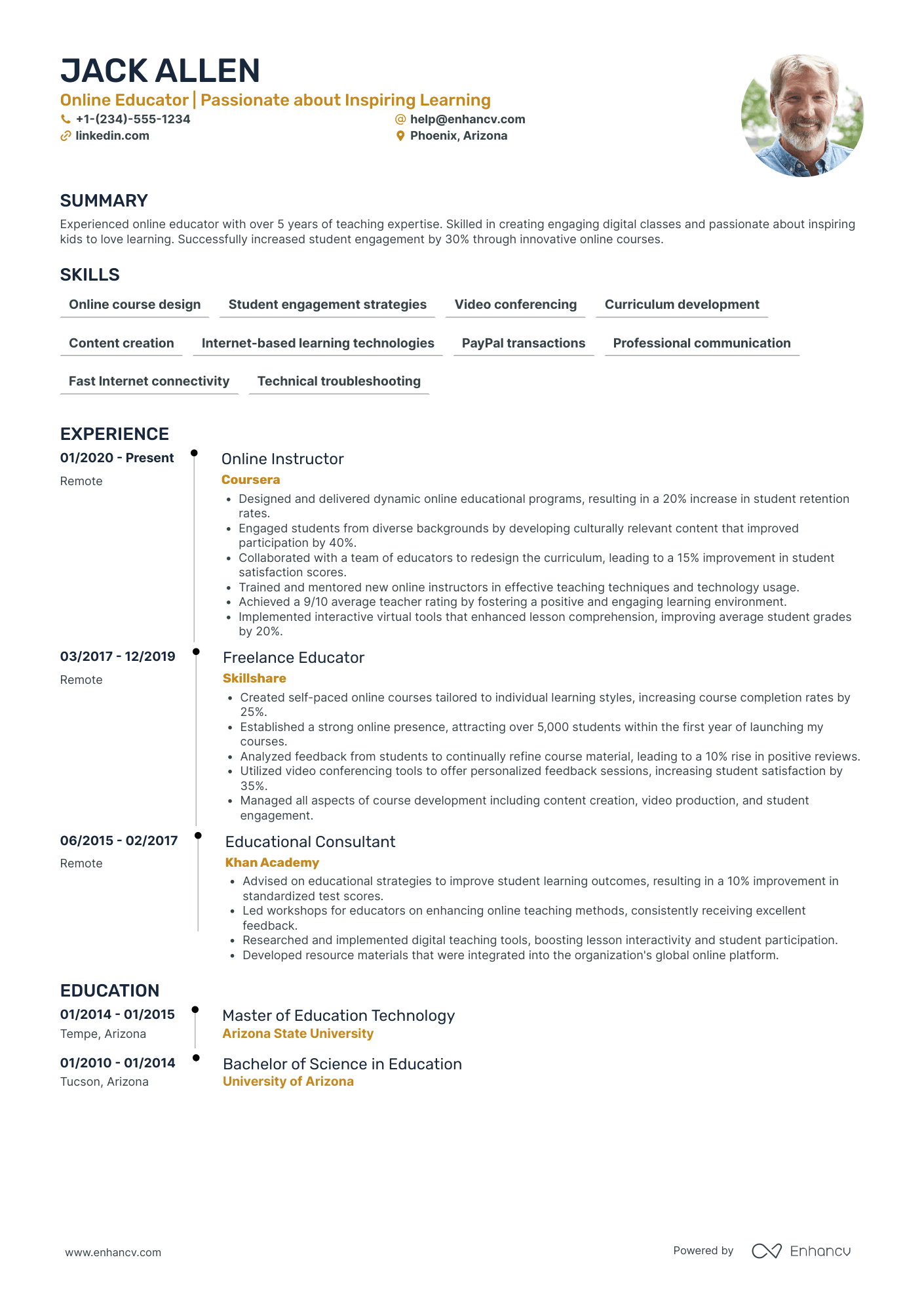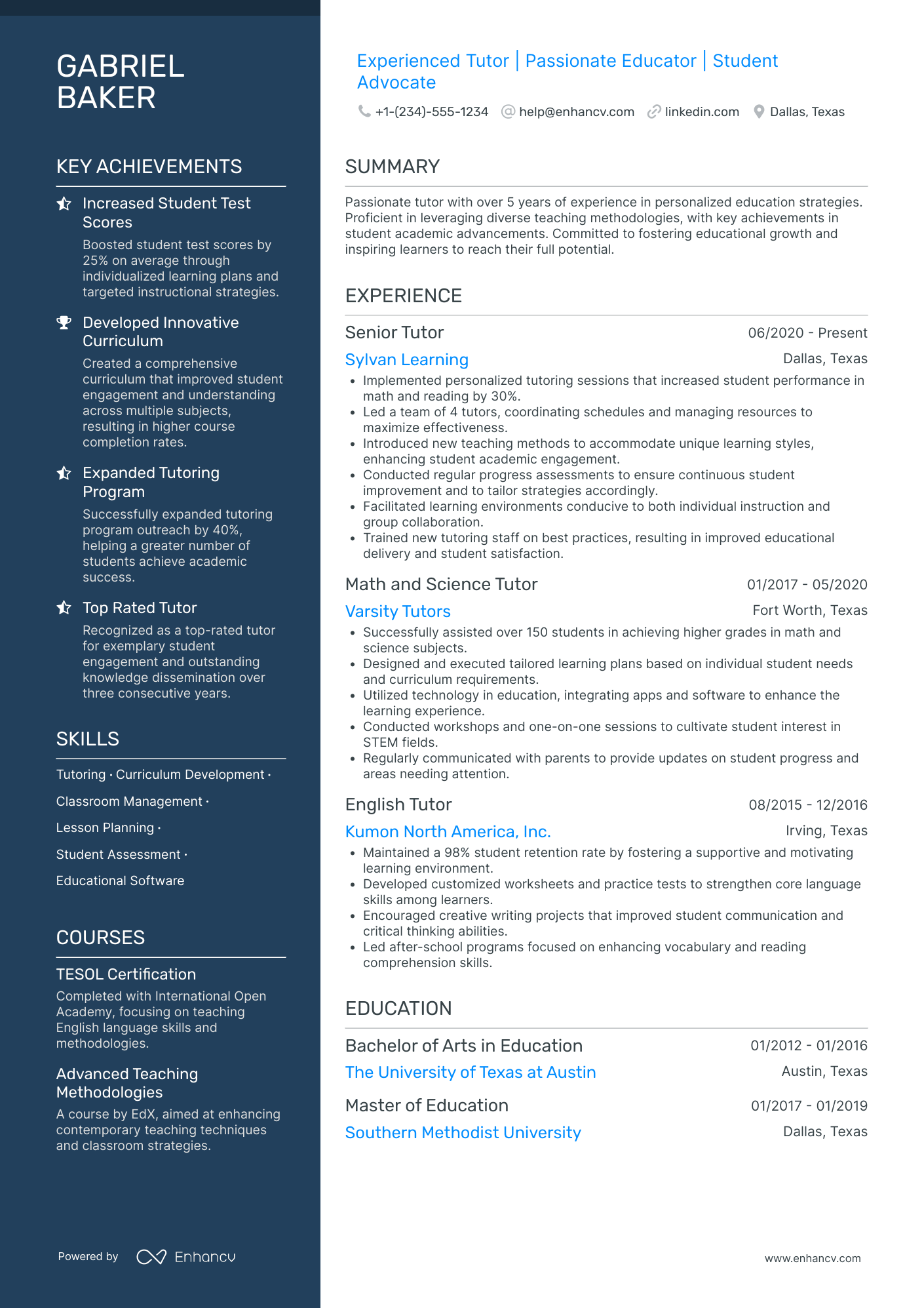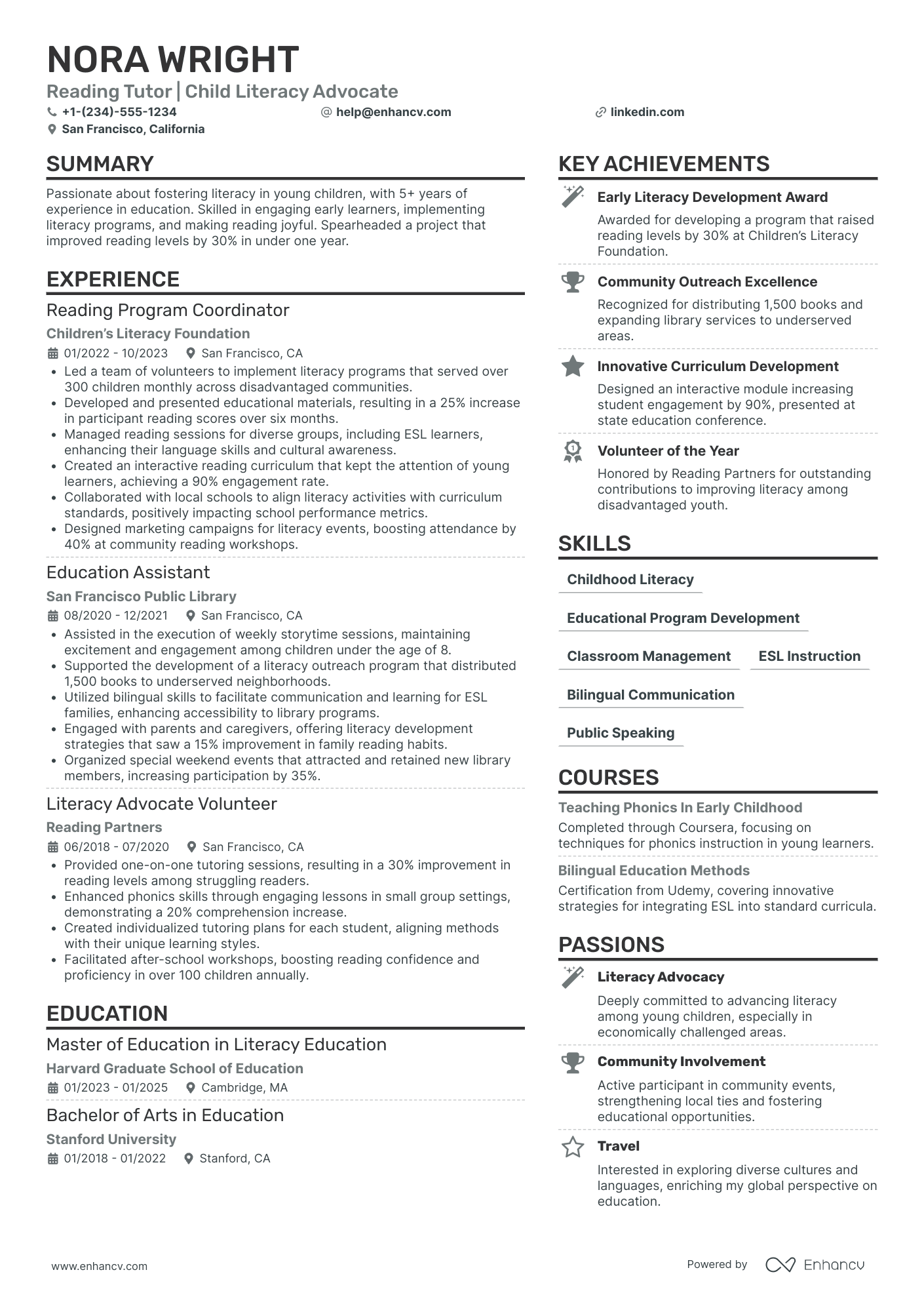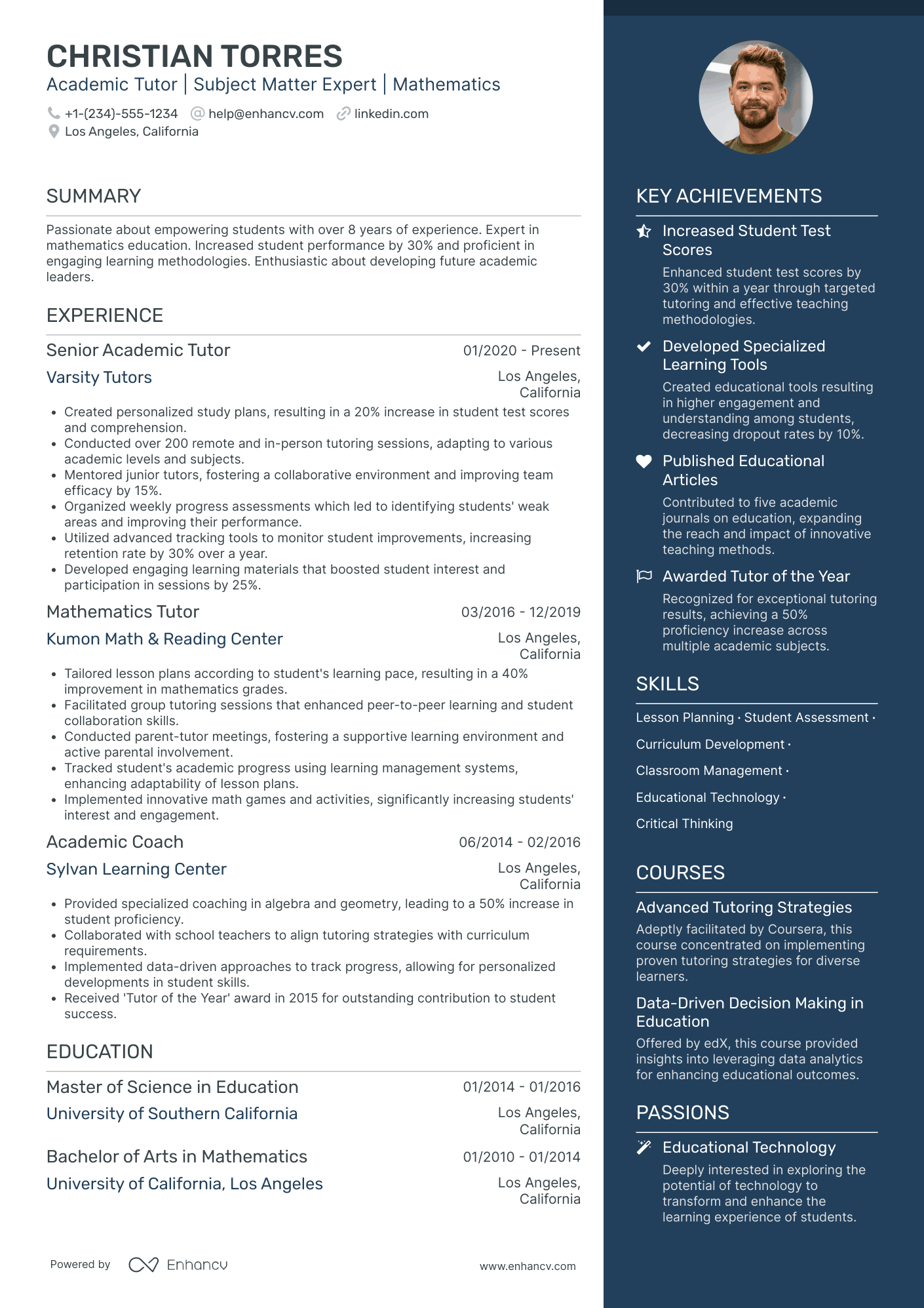With the popularity of tutoring increasing, there is a growing demand for experienced tutors specializing in a range of subjects. The most requested subjects today include STEM subjects, coding and computer programming, standardized test prep, and music and arts education.
If you are searching for a new tutoring position, you’ll need to update your resume to reflect the skills and experience listed in the job post. To do this effectively, you need to be aware of the common issues and challenges tutors face when updating their resumes.
In this guide, we’ll use real-world examples from professional tutor resumes that demonstrate how to:
- Effectively highlight communication skills, emotional intelligence, problem-solving skills, and other soft skills that are crucial for tutors to better understand their students’ needs and design personalized lesson plans.
- Create a focused resume that targets a specific age group and subject matter that lines up with the job requirements.
- Show evidence of student progress and development by including a portfolio link that demonstrates student progress stories, academic achievements, articles, books, and lesson plans you developed, and other tutoring accomplishments.
- Highlight personal development through continuing education courses, teaching seminars, workshops, and other development programs.
By the end of this guide, you will have developed a targeted tutor resume that quantifies specific metrics and highlights necessary skills that will put you at the top of the call sheet.
If you are looking for a more specific type of tutor resume example, check out some of our related ones:
Tutor resume examples
By Experience
Bilingual Spanish Tutor
Advanced Chemistry Tutor
Certified IELTS Tutor
Entry Level Tutor
- Clear Structure and Conciseness - The resume demonstrates an admirable organization, with distinct sections for experience, education, skills, and achievements, all crafted concisely. Each section attributes focused attention to relevant accomplishments and responsibilities, presenting a coherent story of the candidate's career path and expertise without overwhelming the reader with unnecessary details.
- Consistent Career Growth with Strong Educational Backing - Christian Torres’ career trajectory showcases an impressive progression in the field of academic tutoring. Starting as an Education Support Specialist and moving up to an Academic Tutor reflects a consistent commitment to enhancing student performance. The solid educational background with degrees in Education and English further anchors their expertise and professional development.
- Innovative Tutoring Methods and Tools - The resume highlights unique industry-specific elements like the development of an online tutoring portal and advanced tutoring strategies certification. These innovations not only demonstrate technical depth but also illustrate the candidate’s initiative in applying modern methodologies to increase student accessibility and engagement with remote learning.
By Role
Freelance Tutor
The world of freelance tutoring is rooted in the education sector, and as such, education trends greatly impact tutoring operations.
To be a more effective candidate for freelance tutoring roles, consider these guidelines:
- Show your proficiency in different modes of teaching. It could be online tutoring, individualized approaches, or curriculum alignment. These methods should resonate with your resume.
- Make sure you highlight your relevant teaching experiences. The tutoring field values practical experience.
- Emphasize your subject specializations, and the positive outcomes they had on your students' performance. Be sure to include any unique techniques you've developed and how they've helped improve student learning.
- Don’t just list your qualifications. Rather, present how these qualifications have contributed to student success. For instance, 'improved the reading level of...' or 'boosted test scores by...' always use the 'qualification-activity-outcome' format.
Math Tutor
College Tutor
Online Tutor
Private Tutor
Private English Tutor
Online Physics Tutor
Professional Music Tutor
In-Home Homework Tutor
SAT Preparation Tutor
Freelance Academic Tutor
ESL (English as a Second Language) Tutor
STEM Learning Tutor
- Comprehensive Career Development - Gabriel Baker's career trajectory is effectively illustrated through strategic career moves from a Science Tutor to an Academic Learning Facilitator. Over time, he has taken on increased responsibilities, such as mentoring a large number of students, coordinating with different stakeholders, and implementing new learning strategies. This progression reflects his growing expertise and dedication to STEM education.
- Impressive Quantitative Impact - The resume showcases Gabriel's contributions through significant achievements, like a 25% improvement in student academic performance and a 20% increase in resource utilization. These metrics not only highlight his ability to drive measurable improvements but also accentuate his impact on enhancing educational standards and outcomes.
- Adaptability in Diverse Educational Environments - The resume demonstrates Gabriel's flexibility and ability to adapt his teaching strategies across different educational settings. By successfully implementing live streaming sessions and devising tailored academic plans, Gabriel illustrates his capacity to evolve with changing environments and student needs, ensuring a positive learning experience.
High School Biology Tutor
- Comprehensive Career Development - Alexander's career trajectory is well-documented and shows a consistent growth path from a biology tutor to a high school biology teacher. This progression highlights his ability to handle increasing responsibilities and his dedication to the field of education, exemplified by his role in mentoring new teachers.
- Impactful Educational Achievements - The resume is packed with specific, measurable achievements that illustrate Alexander's effectiveness as an educator. For instance, his ability to improve student test scores by a significant margin, such as a 30% improvement district-wide, underlines his impact on student learning outcomes and the overall success of the biology programs he has led.
- Innovative Teaching Methodologies - Alexander's expertise in utilizing educational technology and innovative teaching strategies stands out. The use of digital tools for remote learning and project-based initiatives showcases his adaptability and commitment to enhancing the student learning experience with modern educational resources.
Early Childhood Education Tutor
- Structured Presentation and Clear Content - Zoey Walker's resume is well-structured and clear, with defined sections for experience, skills, education, courses, and achievements, making it easy for the reader to navigate and understand her qualifications and career path. The use of bullet points and concise language ensures that critical information is highlighted and accessible.
- Progressive Career Trajectory in Education - The resume outlines Zoey’s consistent career growth within the field of early childhood education, showcasing her transition from a Childcare Provider to a Teacher Assistant, and then to an Afterschool Program Coordinator. This progression demonstrates her capability to take on increasing responsibilities and leadership roles within her industry.
- Impactful Achievements with Tangible Outcomes - Zoey's achievements section highlights accomplishments with specific, quantifiable results, such as improving lesson plan execution by 25%, boosting reading comprehension scores by 30%, and increasing program enrollment by 20%. These achievements demonstrate not only her effectiveness in educational settings but also her ability to deliver meaningful and measurable improvements.
AP English Literature Tutor
- Structured Clarity and Conciseness - The resume stands out with its clear and structured presentation. Each section follows a logical order, starting from a detailed summary to experience, skills, and education. The use of bullet points in the experience section helps to quickly convey key accomplishments and responsibilities, ensuring the information is easy to digest and concise.
- Career Advancement and Industry Consistency - Jack's career trajectory is noteworthy, showcasing consistent growth within the online education industry. His progression from an Educational Consultant to a Freelance Educator, and eventually an Online Instructor, highlights both his dedication to the field and his ability to leverage his skills in different capacities within the same industry.
- Emphasis on Impactful Achievements - The resume is rich with achievements that indicate the real-world impact of Jack's work. Rather than just listing tasks, the experience section emphasizes how Jack increased student retention rates, enhanced participation through culturally relevant content, and achieved high satisfaction scores. These accomplishments are quantified, providing clear evidence of his ability to create positive educational outcomes.
Essay Composition Tutor
- Educational Impact and Innovation - Gabriel Baker's resume stands out due to his clear focus on educational impact, demonstrating an ability to increase student test scores by 25% through the development and implementation of individualized learning plans. His innovative curriculum design showcases a commitment to not only engage students but also improve their understanding across subjects, resulting in tangible improvements, such as higher course completion rates.
- Leadership and Program Expansion - A significant highlight of Gabriel's career trajectory is his ability to lead and expand educational programs. As a Senior Tutor at Sylvan Learning, he successfully coordinated a team of tutors, managing resources to enhance educational effectiveness. His leadership is further evidenced by expanding tutoring outreach by 40%, underscoring his capability to drive organizational growth and extend educational benefits to a broader student base.
- Adaptability and Cross-Functional Experience - Gabriel's experience across various tutoring roles in different organizations highlights his adaptability and cross-functional expertise. His work history spans roles in math, science, and English tutoring, revealing versatility in teaching multiple subjects. Additionally, his proficiency in developing tailored learning plans and integrating technology into education reflects an ability to adapt teaching strategies to meet diverse student needs and leverage tools to enhance educational delivery.
Reading Comprehension Tutor
- Clarity and Structure - The resume is neatly organized, beginning with a brief but comprehensive summary that efficiently conveys Nora's dedication to child literacy. Each section is clearly delineated, allowing for seamless navigation, while her professional experiences are presented in reverse chronological order, maintaining clarity and concise presentation throughout.
- Career Advancement and Growth - Nora's progression from a Literacy Advocate Volunteer to Reading Program Coordinator reflects significant career growth. This upward trajectory demonstrates her increased responsibilities and leadership capabilities, pointing toward a committed career path in education and literacy.
- Specificity in Educational Expertise - The resume includes technical expertise in childhood literacy captured through roles requiring program development and curriculum design. Nora's degrees from prestigious institutions along with relevant courses and certifications deepen her education credentials, highlighting a robust foundation in innovative literacy methodologies.
Academic Tutor
- Concise presentation with structured sections - The resume is well-organized with clearly defined sections such as experience, education, skills, and achievements. This clarity aids in quickly locating relevant information and provides a comprehensive overview of the candidate's qualifications without unnecessary elaboration.
- Diverse career trajectory demonstrating growth - Christian's career path highlights a steady progression from roles like Mathematics Tutor to Senior Academic Tutor. This trajectory indicates both personal development and a growing depth of expertise in mathematics education, suggesting a commitment to advancing within the field.
- Use of innovative methodologies - The resume emphasizes Christian's ability to create engaging learning materials and personalized study plans, which are crucial in the field of education. These methodologies not only demonstrate creativity but also a deep understanding of effective teaching strategies that cater to different learning styles and needs.
Before we get into adding your work experience, education, and various technical, teaching, and interpersonal skills, we need to make sure your resume is formatted correctly.
How to Format a Tutor Resume
The proper format can make or break your chances of getting an interview, especially when it comes to resumes. Not only do you need to know the correct document settings, you need to be familiar with which sections to include and how to best format your skills, experience, and education.
The standard resume format settings include:
- One-inch margins on all sides
- A standard black font color
- Line spacing set to single-space
- A white background color
If you are building a resume from scratch, these are the same settings as any new Word or Google Doc, so you typically don’t need to worry about setting these.
If you want a jumpstart on your resume building, use our online resume builder to get started.
One decision you’ll need to make when creating your resume is the type of style or layout. There are several different themes you can choose from:
- Traditional: This is the more common choice for resumes. It has a classical, cleaner look that is simple and easy to read.
- Modern: Offers a more visually pleasing resume by using different colors, backgrounds, and icons to help you stand out.
- Creative: This theme is a bit more unconventional and can include graphics, QR codes, and photos, and is best for those in the creative industry.
- Simple: A basic resume template that offers an organized layout that is efficient and streamlined and draws attention to your professional qualities and achievements.
These templates and other Enhancv resume templates are accepted by applicant tracking systems.
Some other important formatting tips you need to consider:
- Page limit: The max page limit is two pages. Any more than that, and it likely won’t be read.
- Single or double-column formats: A two-column layout allows more experienced tutors to add more information on a single page and is accepted by applicant tracking systems.
- Resume file type: When you submit your resume, send it as a PDF document (.pdf). This is the most widely accepted document type for all resumes and will maintain the look and feel of your tutor resume.
- Font choices: Only use a serif or sans serif font, like Exo 2, Lato, Montserrat, Railway, and Volkhov. Avoid any decorative or script fonts.
Enhancv resume templates come with a wide selection of acceptable fonts that you can use.
Keep in mind the market you’re applying to – a Canadian resume, for instance, might have a unique layout.
Is your resume good enough?
Drop your resume here or choose a file. PDF & DOCX only. Max 2MB file size.
Want to see how your resume stacks up with others? Run it through our resume checker for an in-depth analysis and tips on how to improve it.
Let’s take a look at the must-have sections that you’ll need to include:
The top sections on a tutor resume:
- Contact information: Include your full name, job title, professional email address, cell phone number, and a link to a professional social media account, website portfolio, or teaching channels.
- Qualifications and skills: You will list all relevant hard and soft skills, including experience in specific education software, lesson plan development, and other computer or software skills, along with interpersonal skills, communication skills, conflict-resolution skills, and other necessary soft skills.
- Work experience: A detailed list of up to 3 jobs demonstrating your tutoring abilities and quantifying any accomplishments in school performance, reduction in learning difficulties, or the number of students taught.
- Education and certifications: Include all post-secondary degrees, continuing education courses, and teaching certifications.
- References: A first-hand account from past employers and families you worked with can validate your skills and experience and give recruiters a better sense of your abilities.
To help you get started, we gathered a list of the most sought-after experience and qualifications that recruiters expect from new hires:
What recruiters want to see on your resume:
- Specialist subject knowledge: Highlighting knowledge of specific subjects, such as computer coding, test preps, or foreign language, allows recruiters to know you have experience in the subjects listed in the job post.
- Experience with different teaching methods: Showcasing your experience with various teaching methods, like the Socratic method or using e-learning tools, shows recruiters you are adaptable and are current with the latest learning tools.
- Patience and understanding: These soft skills are essential for any tutor to demonstrate their ability to stay calm with challenging students and show they are heard so they don’t become discouraged with their learning.
- Strong communication skills: Proof of active listening and superb written and oral communication skills are necessary to understand and relate to the student’s needs and show you can form a close connection with your students.
- Proven track record of student improvements: Recruiters love to see you quantify your teaching accomplishments through increases in test scores, attendance rates, and developmental progress.
Now that we know what to focus on, let’s jump in and add your relevant tutoring experience. If you are looking for your first tutoring position, we’ll show you the types of jobs and experience recruiters like to see from first-time tutors.
How to Write Your Tutor Resume Experience
The resume experience section is where you’ll add any professional tutoring experience. This can include freelance tutoring jobs, short-term tutoring assignments, private family tutoring jobs, and part and full-time tutoring jobs in a teaching facility.
There are a couple of different ways you can format this section. Each format has its benefits, and which one you choose depends on where you are in your tutoring career:
- Chronological: For tutors with over 5 years of tutoring experience. This format highlights your most relevant work experience and skills. If you are applying for a tutoring position that requires Standardized test prep, you want to list those jobs where you taught those subjects first.
- Reverse chronological: For those with 1-5 years of professional experience. You will include all tutoring experience, no matter the subject specialty, starting with your most recent work experience.
When adding each job entry, you want to include the job title, company or family name, dates of employment, subject matter specialty, and 4-8 bullet points detailing your tutoring experience.
Be careful when adding your work experience. Many tutors fail to take full advantage of this section and properly list their experience in a way that demonstrates their tutoring abilities and successes.
Let’s look at a real-world example of a tutor's resume experience to demonstrate how to best format each job entry.
- •Instructed students in college-level subjects matters.
- •Crafted instructional activities.
- •Composed engaging lesson plans
- •Evaluated teaching methods and materials for each student.
- •Documented student growth and material mastery.
- •Brainstormed with students in setting academic and career goals.
The main goal of the resume experience section is to answer the following question: How well can you tutor our students in the subjects they need to learn?
Does this example do this? Not really. They list the job requirements, but they fail to demonstrate the effect they have on their students, which is something recruiters and parents will look for.
This example also falls short of using relevant keywords that applicant tracking systems will search for and highlight your resume as qualified for the role. Nor does it list any information about the subjects they taught.
Let’s see if we can improve this example by adding more details.
- •Instructed 50+ students, using a mastery of 6 college-level subjects matters, including math, physical science, English, computer coding, Spanish, and history, and updated methods to provide in-depth reviews and practice problems.
- •Crafted instructional activities with attainable goals, empowering students in leading specific academic skills while increasing testing scores by more than 20% on average.
- •Composed engaging lesson plans, allowing students to further their understanding of complex materials, boosting motivation and lesson preparation for 87% of students
- •Evaluated teaching methods and materials for each student, making alterations on an individual basis to meet students' needs, allowing 100% of students to feel engaged in learning.
- •Documented student growth, material mastery, and engagement sharing information with students and/or parents and teachers that improved teacher/parent satisfaction scores by 33%.
- •Brainstormed with students in setting academic and career goals, designing customized lesson plans based on student interest.
We now have a very impressive answer to our question. Notice how this person included the specific subjects they taught and their accomplishments. This is important to include because most recruiters need to know which subjects they have experience in.
Other things this example does well include:
- Creates a targeted resume by including specific subject matters.
- Highlighting the number of students taught.
- Quantifies multiple tutoring metrics.
- Details their creation of engaging lesson plans that motivate students
- Demonstrates their ability to adjust teaching plans based on student interest and performance.
If you are unsure how you can quantify your tutoring accomplishments, we’ll show you some other examples of how to include this crucial information next.
How to quantify impact on your resume
To make your tutoring resume stand out, you need to do more than list the duties, responsibilities, and lesson plans you created. You want to include the effect you had on your students and other accomplishments, like the number of subjects you mastered and increases in test scores. How?
Using numbers and percentages in a resume allows tutors to quantify how they helped their students learn and improve their grades and self-esteem. Which tutoring metrics can you quantify? Let’s take a look at some real-world examples of resumes that quantify various metrics:
- Number of students tutored: “tutored 25 college students in English Language and Literature, with a 100% subsequent pass rate with an average test score above 90%.”
- Number of group sessions led: “Led 8 summer workshops for 20 creative writing students, which helped students produce a 30-page short film.”
- Percentage of student’s improvements in test scores and grades: “Implemented personalized student strategies to improve standardized test scores, resulting in a 25% increase on SAT, ACT, and other college prep tests.”
- The age range of students taught: “Assisted students ranging in ages from 13-18 in understanding course materials and answering student questions, resulting in a 30% increase in student engagement.”
- The number of subjects mastered: “Mastered 6 college-level subjects ranging from JavaScript, Python, C++, and other AI coding programs.”
- Duration of longest tutoring relationship: “Private tutor for the Sullivan family for 10 years, in which all children excelled in junior high and high school and graduated with top honors.”
- Number of lesson plans developed: “Created and implemented 47 lesson plans covering all high school subjects, produced classroom materials based on student feedback, and created 10 mock SAT exams that produced a 20% average increase in test scores.”
- Number of educational materials created: “Developed 6 new interactive lesson plans covering STEM subjects that base follow-up questions on the correct or incorrect answers to previous questions.”
While you don’t need to quantify every bullet point, you do want to focus on the keywords in the job post. If it focuses on improving foreign language skills, you want to quantify your accomplishments in tutoring students in a specific foreign language.
How do I write a tutor resume with no experience
Writing the resume experience section when you have no tutoring experience does present a challenge for first-time tutors. You want to show that you have real-world work experience, but do you really need to include that summertime lifeguard job?
Not unless you taught new lifeguards about lifeguarding procedures or taught swimming on first aid, CPR, or other life-saving lessons.
Demonstrating your transferable skills from unrelated jobs is one of the main issues that tutors need some help with. Tutors can come from a wide range of industries, including:
- K-12 and higher education teachers
- Research scientists
- Computer programmers
- Healthcare professionals
- Business and finance professionals
- Artists
The type of jobs you’ll list will mostly depend on the subject matter of the job you are applying for. You want to only include those jobs where you have the skills and subject matter expertise listed in the job post.
Take a look at this job post for an entry-level academic tutor.
From this post, you can gather they are looking for a tutor with experience developing literature and math lesson plans, and that is what you want to feature on your resume. You’ll also want to highlight your experience with:
- Experience with leading one-on-one and small group sessions.
- Experience with behavior management systems like Class Dojo and Classroom Management System 7.
- Working with teachers to create an engaging, safe, and healthy classroom.
- Experience collaborating with team members or teachers.
Now, let’s spend some time discussing how you will list your tutoring skills, computer software knowledge, and other relevant skills.
How to List Your Hard Skills and Soft Skills on Your Resume
tutors need to demonstrate a wide range of technical, creative, and personal skills to show they have what it takes to have a positive impact on their education. There are multiple ways that you can add your skills, but first, a little explanation of the difference between hard and soft skills.
Hard skills cover what you learn through college courses, teaching seminars, workshops, and continuing education classes. They cover essential skills, such as proficiencies in math, English, science, and other STEM subject matters, foreign language mastery, knowledge of online teaching tools like Kahoot and Quizlet, and other technical and subject matter mastery.
Soft skills are those personal skills that you pick up naturally by interacting with friends, family, and peers. These skills include emotional intelligence, excellent communication and listening skills, conflict resolution, and being able to adapt to any teaching scenario.
Take a look at this list of hard skills as an example of what recruiters like to see the most.
Best hard skills for your tutor resume
- Mathematics proficiency
- Science expertise
- Advanced knowledge of English literature
- Proficiency in a foreign language
- Understanding of the history curriculum
- Expertise in computer science
- Knowledge of education software
- familiarity with online teaching platforms
- Knowledge of Microsoft Office
- Use of digital tools (Kahoot, Quizlet)
- Experience with Learning Management software (Blackboard, Moodle)
- Grading and evaluating student's work
- Creating and editing digital content
- Proficiency in conducting educational assessments
- Expertise in specific test preparation (SAT, ACT, AP exams)
- Use of interactive whiteboard technologies (Drawp for School, Invision by Freehand)
- Knowledge of special education practices
- Familiarity with child development and psychology
- Coding skills (Python, JavaScript)
- Proficiency in easing e-learning software (Adobe Captivate, Articulate Storyline)
Pay close attention to which soft skills you add to your resume. This is another area where tutors don’t fully demonstrate their experience with these skills.
Best soft skills for your tutor resume
- Patience
- Strong communication
- Empathy
- Active Listening
- Time management
- Adaptability
- Reliability
- Organizational skills
- Critical thinking
- Cultural awareness
- Motivational skills
- Problem-solving
- Interpersonal skills
- Creativity
- Flexibility
- Dedication
- Conflict resolution
- Leadership
- Positive reinforcement
- Respectfulness
You don’t want to include every single skill you have in one section. That wouldn’t look very good and would create a resume for too long. You can include subject matter mastery under Enhancv’s technical skills section.
List the subject matters that are listed in the job post first.
For your soft skills, Enhancv has several different sections where you can include these skills. The talent section is where you can add important soft skills and experience using them.
Our passion section is a good place to list those traits that make you a passionate tutor.
The next must-have section for your resume is the education section. This is where you will list any accredited degree or certification program through a university or online organization, like the National tutoring Association.
How to List Your Certifications and Education on Your Resume
Today’s tutors come from diverse educational backgrounds and hold bachelor's degrees in computer programming, business administration, healthcare, psychology, and many other fields.
If you have a degree that is not typically associated with education, you will need to include any formal teaching certificate if you want to work as a tutor.
Parents and private tutoring gigs may not require any specific degree, but you still want to include any post-secondary education, teaching certifications, and any continuing education courses.
When listing your education, you want to include:
- Degree name and subject
- School name and location
- attendance/graduation date
- 4-8 bullet points listing courses taken
If you don’t have enough work experience or are going for your first tutoring job, include the bullet points. Those with 5 or more years of experience can leave them out.
Your tutor resume education section will look something like this.
- •Favorite fields of study: American poetry: From Modernism to Postmodernism, Creative Expression in Writing, Creative Nonfiction
- •Thesis title: “An Analysis of the Impact of 1940s Blues Culver on the Poetic Expression of the Members of Harlem Renaissance
- •Key achievements: Awarded $15,000 2023 Drue Heinz Literature Prize for a collection of short stories, “Your Latest Trick
- •Favorite field of study: Introduction to Literature Study: Comparison, Cosmopolitanism, and the Global Novel, Literature Gone Viral, Digital Humanities, Radical Arts, Re-Thinking Derrida, Being as a Spectacle.
- •Thesis title: Toward the Derridian Deconstruction of the Notion ‘Biography’ on the Basis of Julian Barnes’ 1984 novel Flaubert’s Parrot
- •Dean’s List 2021 - 2023
- •President of the undergraduate student board from 2022 to 2023
- •Started and ran a discussion club on Russian Postmodernism Literature
- •Chief Editor of the university blog from 2022 to 2023
For your certifications, workshops, and other specialized training, you can include the name of the certificate or training and the organization that provided it.
Here are some of the certifications you can apply for if you are looking to advance your career.
Best certifications for your tutor resume
This next section is where you will include a personal statement about your intentions that includes details found in the job requirements.
How to Write Your Tutor Resume Summary Or Objective
If your resume is the key to the door, your resume summary or objective is your greeting. So, what’s the difference between a resume summary and a resume objective, and which one should you use?
A resume summary is for tutors with 5+ years of experience and a stable career history specializing in certain subject matters. You will summarize your career to date, quantifying specific achievements and demonstrate why you would be a good fit for the role.
A resume objective is for those who are fresh out of college and looking for their first tutoring position or those with only a few years of tutoring experience. You have no career to summarize, so you will list your career objectives and some key skills that will help you get there.
Let’s take a look at another real-world tutor resume summary example.
Here is an example of how the majority of tutor resume summaries look. It’s not bad, but it lacks the oomph and pizzazz we want.
You want to avoid vague terms like “various levels of learners.” You can be more specific here and really show some of your accomplishments.
We can see how adding some specific details can really improve a resume summary. We now have a better idea of this person:
- Specific area of subject mastery
- The number of students taught
- The age range of the students
- Number of lesson plans developed/implemented
- Experience with a number of essential soft skills
- A commitment to learning
When you summarize your career, keep in mind your page limit and keep it to 3-5 concise sentences.
If you have just a few years of experience as a tutor and are looking for your next gig, your resume objective will look something like this.
Be sure to scan the job post for specific keywords so that you can include them in your personal resume statement.
Additional Sections for a Tutor Resume
Throughout this guide, we’ve discussed the main sections of your resume and how best to format them. If you did not get to include all of your relatable skills or accomplishments, there are some additional sections where you can put this information.
Two of the more popular sections for tutors include your tutoring philosophy and tutoring references.
Including past work references is an excellent way to give recruiters and private families a better sense of your experience and abilities.
Always make sure you have permission to list a past employer if you can use them as a reference and which contact info you can use.
Some other sections that you should consider adding include:
- Foreign language
- Volunteer tutoring gigs
- Testimonials/references from teachers and parents
- Technical proficiencies in business software
- Achievements and awards in tutoring
Adding a portfolio link to your resume
tutors need to show that they are current with the latest technical and teaching tools while demonstrating their effectiveness in teaching students. One of the better ways to do this is by having an online portfolio.
Website portfolios allow tutors to showcase student successes, feature online learning modules they created, awards, publications, and other career highlights. You can also add links to a professional social media account or media channels where you develop lesson plans, like:
- LinkedIn: A business social media site where tutors can share accomplishments, tutoring news and information, and other related content.
- YouTube: Many tutors have a YouTube channel where they create learning videos for their students.
- TikTok: One of the latest tools for tutors. You can create 60-second video clips as learning tools and interact with your students on a platform that is more popular with the younger generation.
Where can you add a portfolio link? Use the header section and instead of adding a social media link, swap it for a link to your portfolio:
If you have multiple learning channels but don’t have a website portfolio, you can add this information under the social media section with links to the page.
Key Takeaways
In this guide, we showed you some of the common problems tutors face when updating their resumes and how to take your resume from an average C to an A+.
You now have a tailored resume that includes all relevant information as well as:
- Demonstrates essential soft skills, highlighting your communication skills, emotional intelligence, and adaptability in creating personalized learning plans.
- Details relevant work experience and quantifies various tutoring metrics, like higher test scores, number of students taught, and number of subjects mastered.
- Showcases student achievements and tutoring accomplishments through an online portfolio, YouTube channel, or other social media account.
- Highlights your passion for learning and any current courses you are taking.
